#‘it’s a historical document’ then put it where it belongs in a history class
Explore tagged Tumblr posts
Text
when are we gonna break it to american conservatives that we already HAVE schools that teach the bible and they are called private christian schools. oh right i forgot they don’t actually care about that and are trying to enforce a state religion
#for the love of christ can we not make it mandatory to teach the bible#‘it’s a historical document’ then put it where it belongs in a history class#but no you’re hanging up the ten commandments in homeroom#i’m so pissed about this#if you want your kid to learn about the bible and you don’t have the money for private school i have an easy tip: TAKE THEM TO CHURCH#sorry this isn’t really funny this is just a rant#first that godawful ‘plots of heaven’ thing and now this#i know outrageous stuff is always going to happen but with the upcoming election looming i am gritting my teeth#tw us politics#bc i sure as fuck know if i wasn’t in the us i wouldn’t want to constantly hear about this shit
29 notes
·
View notes
Note
To what extent do you think that a belief that communism would follow from the collapse of capitalism is an ideological assumption vs a conclusion based on empirical investigation?
i think it depends on the nature of the belief. lots of people seem to think that communism is inevitable due to iron historical laws and i think that's pretty silly, projecting a historically situated set of political preferences onto history itself. there's no reason why communism has to happen or even why capitalism had to happen. these developments can really only be understood retrospectively. i think this is "ideological" in a sense, and (among marxists) generally has something to do with an overly deterministic rendering of marx's work. i think elements of this are in marxs work, for sure, but that's definitely not all there is and i think many of his bold historical claims serve a propagandistic function rather than being honestly descriptive.
easy example would be the manifesto, where he makes some very strong claims about this stuff, like this one:
"The advance of industry, whose involuntary promoter is the bourgeoisie, replaces the isolation of the labourers, due to competition, by the revolutionary combination, due to association. The development of Modern Industry, therefore, cuts from under its feet the very foundation on which the bourgeoisie produces and appropriates products. What the bourgeoisie therefore produces, above all, are its own grave-diggers. Its fall and the victory of the proletariat are equally inevitable."
this begins with an attempt at describing a tendency based on a set of political economic assumptions which are falsifiable in all the ways that people like to make a fuss about, but it ends with a passionate claim about a historical inevitability. the latter claim doesn't necessarily follow from the former, and it would have to be shown why the bourgeoisie as the "involuntary promoter" of modern industry leads to an inevitable victory of a competing class (putting aside the complicating fact that a victorious proletariat is a non-proletariat), rather than a purely economic tendency of self-collapse. this kind of deterministic reading would actually run into conflict with the first sentence of the manifesto regarding history as a history of class struggles since no class struggle would be necessary for capitalism to end, and this is even how certain people read marxs later work like capital, where the "expropriators are expropriated", which is "accomplished by the action of the immanent laws of capitalistic production itself, by the centralisation of capital" rather than as a result of violent class struggle.
but if we were read this bit of the manifesto more generously (probably too generously), there is something to be said about how the fall of the bourgeoisie and the victory of the proletariat as equal inevitabilities is not necessarily the same as saying that they are in fact totally inevitable. they are either inevitable or they are not, but equally so. this could also comes into conflict with rendering of marx as an economic determinist, since the laws of capitalist production could lead to the dissolution of the system on their own, without any inevitable victory on the part of the proletariat, negating their assumed equality. it should also be noted then, that in order for this generous reading of this section to work (if it can), the "fall of the bourgeoisie" would likely have be taken as being of a particular sort. if the sun exploded tomorrow and ended capitalism forever, it could not be described so narrowly as the "fall of the bourgeoisie" but of the elimination of human life altogether. by fall, we would have to refer to it in the sense of the outcome of a competition between classes.
elsewhere in the text, marx also leaves room for a more open-ended approach, when he talks about the historical struggle between classes as "a fight that each time ended, either in a revolutionary reconstitution of society at large, or in the common ruin of the contending classes." floating the possibility of a "common ruin of the contending classes" expresses a very different kind of analysis than the purely economic determinism which can be teased out above. for there to exist a possibility which does not simply belong to the historical chain of revolutionary usurpations of power would suggest that the same could be true for us today. even if it's not exactly at the level being presented, this would in a sense be able to better account for things like the aforementioned explosion of the sun, or some other forces which exist and which we are unable to overcome (like a potentially catostrophic climate event). regardless, this attitude of historical openness is very different than what is found elsewhere in the text, and i think it can be located in various other forms later on in marxs life as well.
by 1882 when marx is writing the preface to the russian edition of the manifesto, he says
"The Communist Manifesto had, as its object, the proclamation of the inevitable impending dissolution of modern bourgeois property. But in Russia we find, face-to-face with the rapidly flowering capitalist swindle and bourgeois property, just beginning to develop, more than half the land owned in common by the peasants. Now the question is: can the Russian obshchina, though greatly undermined, yet a form of primeval common ownership of land, pass directly to the higher form of Communist common ownership? Or, on the contrary, must it first pass through the same process of dissolution such as constitutes the historical evolution of the West?
The only answer to that possible today is this: If the Russian Revolution becomes the signal for a proletarian revolution in the West, so that both complement each other, the present Russian common ownership of land may serve as the starting point for a communist development."
one of the interesting things about this is the first sentence where he talks about the aim of the manifesto as "proclam[ing] of the inevitable impending dissolution of modern bourgeois property", which is a one-sided framing of the problem and manages to put the "equally inevitable" proletarian victory to the side or simply subsumed into it. the latter probably makes the most sense, since he's here arguing that a russian revolution which would be made up of non-proletarian elements could have some revolutionary capacity toward communism, even if the proletariat on a world scale would still need to put in the work toward that aim. in each instance, he is talking to representatives of those elements. this is a political manifesto written to agitate and not simply a treatise of social science. this may get partly lost on 21st century readers, but the russian preface was written for the publication to be read by russian readers. the preface to the italian edition referenced italy as the first capitalist nation and asks its readers "Will Italy give us the new Dante, who will mark the hour of birth of this new, proletarian era?" etc.
it should be clear that there were real political stakes; that marx and engels were not simply describing something they saw around them. the empirical investigation was there in some sense and acted as a motivating force for action, but the particular calls on the revolutionary elements of each country which saw a translation captures the importance of political propaganda and revolutionary agency for the two authors. at times they felt a need to blur the differences between what must happen by iron historical law and what must happen or else we're ruined. this means that this famous document which has generated lots of ideas about what marxism is and how it relates to the historical struggle toward communism is full of theoretical ambivalences, and these exist in some way in many other texts by both marx and engels.
the tensions within and between texts give rise to misunderstandings about the need and possibility of communism, but i don't think that they are reducible to each other so that all claims about a future communism are necessarily ignorantly ideological. if there is a mass political will, and this is definitely what marx and engels were trying to generate with their work, then communism can be possible. the immanent tendencies of capital, which neither thinker really understood that well at the time of writing the manifesto (although it's held up fairly well in many ways), only add to the urgency of the need for such a movement. the destruction is all around us and will keep coming but we can't fall back on the inevitably of communism to save us without anyone ever having to lift a finger. the entire point is that we have to do it ourselves, otherwise the communist movement and its various mouthpieces (like marx and engels) would never even have to exist and communism could simply fall into our collective lap.
84 notes
·
View notes
Text
Meta AU
Thinking about an AU where roughly half of the human population are born with special abilities. Historically, those who were blessed with such powers–referred to as metahumans, or meta for short–reigned over those who did not. Metahumans resided at the top of social ladders, maintained influential positions in government, ran the most successful corporate businesses, and dominated all aspects of society.
Only within the last three hundred years has there been significant progress in uprooting the hierarchical systems. At least, enough to protect regular humans from enslavement, perpetual poverty, and exposure to meta-against-meta violence. Furthermore, the most recent war involving multiple meta-lead tyrannies wiped out more than three-fourths of the existing metahuman population.
One century later, metas are now the minority among regular humans. Their powers are still seen as dangerous and other-worldly. Horrendous myths and anecdotes have bred skepticism and contempt, but the ludicrous chaos of rampant, uncontrolled beasts have been left behind in history books.
Regardless, the newer generation of metas typically doesn’t go around flaunting their powers in public for the risk of judgment and surveillance. Though they are required to register their abilities as soon as they develop through extensive government documentation. Even something as harmless as distinguishing lies from truths or shapeshifting could be used for corrupt reasons depending on the person.
In general, metas kept to themselves in the shadows.
Twenty-four-year-old HC has been putting up with other peoples’ shit his entire life. First, his shitty parents; his mother who neglected and abandoned him; his father who loathed and abused him. Second, his cursed power which physically manifested where others could see.
HC’s power resides in his unmatching eyes–one black, one red–and relies on eye contact. His left “normal-colored” eye can sift through peoples’ memories pertaining to the questions he asks. His right discolored eye puts people in their worst nightmare or lived experience. Once they beg for mercy, an act of submission, HC can manipulate them into doing whatever he says.
Growing up, before HC came of age where metas exhibited hints of their powers, people couldn’t bear to look at his mismatched eyes—especially his father. HC’s father banked on having a child with a beneficial ability for greedy purposes, but all he saw in his son was a useless, abnormal freak.
In addition to covering a sight that provoked others, HC wrapped his head and right eye in bandages due to his fathers’ beatings because of his “ugly” and “deformed” appearance.
Through his adolescence, HC came to fit the cold and intimidating persona people expected of him. Even if he didn’t feel like a monster, HC forced himself to become one. He endured extensive bullying, rumors like he’s out to gouge out someone’s right eye to replace his own, and avoidance overall from others.
Consequently, HC doesn’t look people in the eye. Not only due to the fact they don’t spare him a second glance but also because he’s aware of just how lethal eye contact can be.
Every day, HC spent hours learning how to control his power by looking at himself in the mirror–which he despised doing. He had to train his emotions, his mental images, and cultivate his energy core in order to wield his power with intention.
After finally having enough, HC stirs up the courage to kill his father at the age of sixteen. He packs up the little belongings that are worth taking with him and the small amount of money his father saved up for drinking and gambling.
HC moves to the big city to make a scarce living. He uses a patch to cover his red eye while he uses his left eye’s power to his advantage, working various jobs and gaining as much knowledge as possible. After two years of fending for his own, HC decides on a whim to apply for university—using his vast amount of street skills and blackmail to get in.
There, HC meets a few people who aren’t turned away by his reputation and actually want to befriend him. They seem to be misfits themselves, so he gradually comes to accept them as...acquaintances.
(HC, HX, YSH, and YY best friends agenda.)
HC was always at the top of his classes, using his learned skill to retain endless facts—which he claims to be his power to hide his true ability. Things seem to be going well until one of his classmates and their group of privileged snobs who come from rich families (definitely got some strings pulled to get into the university) targets HC in his senior year. They manage to rip his eyepatch off in a surprise attack.
HC feels utterly violated, a part of him that he hates so much exposed against his will. The power he worked endlessly to conceal flared beyond his control. He ends up killing every single one of the students who cower under his gaze.
The whole event makes national headlines, the display of raw power rocking the public’s perception of metas for the worse. HC, now considered a huge threat, is promptly sentenced to a facility reserved for S-ranked metas, working to contain his powers.
It’s here that he meets a few other patients sentenced to the same fate as him, including Xie Lian.
XL’s superpower is reading people’s emotions and energy by touch. He has also honed healing abilities through special training he had access to, being born into an elite family. However, if XL puts enough hatred into his touch, he can harm and even kill with one simple pat.
He wears a pair of white, leather gloves at all times.
Unfortunately, when an unexplainable plague broke out that resulted in many deaths and lasting consequences, all answers pointed back to XL, who had been hosting an enormous charity event for his family—directly shaking hands and coming into contact with everyone affected by the plague. XL went through an invasive process of investigation and was also scrutinized by the distraught public.
At this time, XL lost a lot of self-worth about himself as a person with these powers. All the years of training to control them seemed to fly out of the window, and it didn’t feel safe to even go outside to the grocery shop.
In the middle of XL’s sophomore year in university, one year after the outbreak, he admitted himself into the institution that hosts dangerous individuals to protect others from another possible tragedy.
One week in, he is subjected to secret horrific experimentation by the head of the facility himself.
All patients are.
When HC arrives at the facility, XL has already been a patient for ten years.
#tgcf#heaven official's blessing#hualian#hualian au#xie lian#hua cheng#tian guan ci fu#cerdrabbles#I desperately want this to turn into a suicide squad au help#hc pov we love to see it#tsundere-turned xl we love to see it#I suddenly don't know how to write
51 notes
·
View notes
Text

Dracula's life from birth to 7 years by Lyzhina Svetlana Sergeevna (Лыжина Светлана Сергеевна) originally in Russian. http://samlib.ru/l/lyzhina_s_s/dracula_7.shtml In this article I have tried to collect ALL the information somehow related to the early childhood of Dracula, and the story of childhood always begins with the story of the birth, so that's where we'll start. When Dracula was born. The year of Dracula's birth is reported differently by different books. Some say 1429 and some say 1431, but all of these statements are based on the same facts. _ _ _ _ _ Fact 1 - Dracula had an older brother, about whom we know that in 1442 he was 13-14 years old. This is reported in Jean de Wavrin's "Anciennes Chroniques d'Angleterre". Fact 2 - Dracula first ascended the throne in November 1448 and began to rule without the help of a regent, which means that Dracula was already 17 years old at the time. _ _ _ _ _ These two facts are the basis of all the assumptions we find in various books, so it is not difficult to guess where the numbers 1429 and 1431 come from. If the elder brother of Dracula in 1442 was 13-14 years old, it turns out that this brother was born around 1428, which means that Dracula himself couldn't have been born before 1429. At the same time, if you count Dracula's age from the time of his first reign, that is, subtract 17 from 1448, you get 1431. By the way, that is why the birth of Dracula is often associated with another fact - the entry of Dracula's father into the Order of St. George (Order of the Dragon). It is presumed that the accession took place no later than January 1431, since in a letter dated February 8, 1431, drawn up in Nuremberg, Dracula's father, among other things, states that he enjoyed the support of Emperor Sigismund of Luxembourg, who was the head of the Order. House in Sighisoara It is common knowledge that Dracula's early childhood was spent in the Transylvanian town of Sighisoara, where our hero lived with his father, mother and older brother until the fall of 1436, which means that at the time of his departure from the "land of childhood" Dracula was no more than 7.5 years old. How many memories could Dracula have of Sighisoara? About as many as each of us remembers of kindergarten and the first school bell. Is it a lot or not - you decide. The house where Dracula lived is located on the corner of Zhestianshchikov Street and Museum Square. Zhestvenshchikov Street is a historical name, and Museum Square was a street in the Middle Ages and, of course, was called differently. The most likely name is Blacksmith's, so you can imagine the sounds that little Dracula heard from morning to night. The mint in the house. It is also known that Dracula's father set up a sort of mint in the family nest. Special people came to the house and were engaged in minting gold money - the very coins with dragons, thanks to which Dracula's father got his nickname. The minting process and the coins themselves looked like this: https://img-fotki.yandex.ru/.../440.../0_acb55_83f50b94_orig Of course, the presence of unauthorized people in the house and the constant hammering of the stamp caused some inconvenience to the family, but it was impossible to move the "production" to another place, because only Dracula's father had the right to mint money, and in order to comply with legal formalities, he had to do it in his own territory. Frescoes in the house Unfortunately, we don't know exactly what Dracula's house looked like in the 15th century. What we see now is the 17th century, but many researchers believe that the house still has something that existed in the 15th century - a mural on the wall of the second floor. I read on the official website of House of Dracula that there were originally 4 people in the mural, although only 3 images have survived. It is believed that the "man in a turban" and the woman next to them are Dracula's parents, and to the right and left of them the artist depicted guests invited to the feast. That the fresco depicts four people, not three, is more than
likely, but the assumption that next to the owners of the house are depicted guests, I personally think wrong, because Dracula's parents, ordering a painting, would have preferred to see there not guests, but really close people, i.e. relatives. I think the mural was a family portrait, not just a sketch from life. The gray-bearded man on the right side of the fresco looks a lot like Dracula's maternal grandfather, the Moldovan sovereign Alexandru the Good. If I am right, the portrait on the opposite side, which is not preserved, belonged to the Romanian sovereign Mircea the Old, Dracula's paternal grandfather. https://img-fotki.yandex.ru/.../4400.../0_acb56_233d42a_orig By the way, there are other frescoes on the second floor, or rather remnants of frescoes. In some places we can see floral ornaments, and on the upper slopes of the windows we can see figures of some people, depicted waist-length and placed in round frames. Most likely, the frescoes on the slopes date from the 16th century, as the numbers 1576 are visible on one of them. The only thing we can say for sure is that these frescoes depict noble people. Near one of the images there is a figure of a two-headed eagle. Next to the other image is the inscription "archi..." (Latin: archiepiscopus - archbishop). In a third image, a woman's hairstyle and a richly patterned dress are clearly visible. https://img-fotki.yandex.ru/.../440.../0_acb57_354e446a_orig Services in the house Dracula's family was Orthodox, and the population of Sighisoara in the 15th century consisted almost entirely of Catholics, since at that time Transylvania did not belong to Romania, but to Hungary, a traditionally Catholic country. There were no Orthodox churches in Sighisoara at all, and this posed a serious problem for Dracula's father and mother. Dracula's parents were supposed to live a church life, which is possible only with the participation of a priest, who can take confession, baptize the newborn, etc. Dracula's parents lived in Hungary for many years - first at the court of Sigismund of Luxembourg, and then in Transylvania - and all this time were away from Orthodox parishes. For example, it is known that in the Middle Ages there were no Orthodox churches in the Hungarian capital. Such a temple appeared only at the end of the 15th century in the neighboring city - in Pest - and was a wooden church built by the Orthodox Serbian settlers. How did Dracula's parents deal with the issue of confession and baptism of their children? After all, someone had to baptize the newborn Dracula as well! Most likely, the parents, being well-to-do people, hired a certain Orthodox priest, who conducted home services, took confessions, etc. By the way, little Dracula, living in Sighisoara, is unlikely to have confessed, because in Orthodoxy all children under 7 years are considered absolutely sinless, and Dracula at the time of his move from Sighisoara to Romania was (recall) no more than 7.5 years. Dracula's first steps in comprehension of sciences If you believe the textbooks on the history of pedagogy, the basic principles of education since the Middle Ages have not changed so much. In the Middle Ages, as now, science was taught from the age of 7, but Dracula probably began learning a little earlier. The Dracula researcher M. Kazaku suggests that Dracula and his elder brother had teachers in common, as the difference in the age of the brothers was insignificant - two years maximum. If further to follow this logic, then it turns out that the older brother Dracula began to learn reading at age 7 as it should be, and Dracula was put in school at 6 or even 5 - just for the company, so that the younger brother did not hang around while the older one was sitting in class. All the textbooks on the history of pedagogy say that in the Middle Ages the teachers of the "book sciences" were from the church milieu. Even if it was to teach a child who was not prepared for a spiritual career, he was still taught by churchmen, because they were the most literate and educated class. By the way,
this is another argument in favor of the assumption that while Dracula's family was wandering around Catholic lands, an Orthodox priest lived there all the time. Dracula's parents needed this priest also because someone had to teach their children to read and write. In any case, we can say with absolute certainty that the literacy learned by the young Dracula was Slavic. He simply could not have been taught Romanian literacy, because it did not exist in the 15th century. If we look at the history of the Romanian language (old Romanian to be exact) we see that it was an oral language until the 16th century. The earliest known letter written in Romanian goes back to 1521 and is in Cyrillic script, because most of the official documents in Romania at the time were written in Slavonic and the liturgies were held in the same language. Exactly in Slavonic, not in Latin, as many people think for some reason! This gives us reason to believe that the little Dracula, as a child of an Orthodox family, studied first of all the Slavic letters, and not the Latin. It turns out that already at an early age Dracula knew three languages: - Romanian, because it was spoken in the family; - Hungarian, because the family lived in Hungarian lands; - Slavonic, because it was the starting point for literacy. It seems incredible that a child at such an early age could be taught a Slavic language - essentially a foreign language - but there is nothing surprising in all this. At a later time in the so-called "classical gymnasiums" young children had to learn two foreign languages at once - Greek and Latin - but no child died or went mad from this teaching. So could not the little Dracula learn the Slavic alphabet? That is, perhaps, all there is to it, and of Dracula's further maturing one can
16 notes
·
View notes
Text
RAMifications Prologue - Breakaway

Book: The Royal Romance (AU)
Pairings: Liam x MC (Ella); Ella x OC
Song Inspiration: Breakaway by Kelly Clarkson
Characters belong to Pixelberry; MC Ella Brooks and Ethan belongs to me
Summary: How Liam met Ella and their love story.
A/N: This entire idea came from Burnsy and her unBEARable series featuring her OTP Drake x Alyssa Devereaux. This is Ella’s backstory and how she met the love of her life King Liam of Cordonia. This doesn’t follow much of TRR books, there is still a social season but not all of the players are present. Throw canon out the window! If you have not read unBEARable by @burnsoslow (catch up here) I suggest you go and read that first. There are SPOILERS in this series!
Warnings: Except cursing? Not much.
Words: 1129
Ella Brooks was sick of school.
At 25 years-old, she had already busted her ass and gotten her bachelor’s degree in history and political science.. Her parents, however, were less than thrilled about her choice in majors. She agreed to go back to school and was almost done with her bachelor’s degree in nursing at the University of California in Los Angeles, just needing a semester of an internship for graduation. Ella had already told all of her professors that she wasn’t doing an internship abroad before graduation. It was the sudden break up with her long time boyfriend that made her change her mind and want to get the hell out of California.
A week ago
As Ella walked to her car from campus - she had put in a study session at the library - Ella heard loud laughter echoing from the outdoor bar next to where she parked. That sounds an awful lot like … she narrowed her eyes just as she saw that it was her boyfriend Ethan. He was laughing with a blonde haired woman, his arm around her shoulders, face close to hers as they held onto their drinks.
Unable to contain her anger she stalked over to the oblivious pair and tapped Ethan on the shoulder. He turned and the smile he had on his face immediately fell, his eyes widened in shock.
“Uh … Ella, hey! Wh-what are you doing here?”
Ella grit her teeth and tried to compose herself. “Ethan. I was studying, as you know since you were supposed to meet me.”
“W-well, something came up after the meeting.”
Ella’s arms were folded in front of her, her brow arched. There was an awkward silence and the blonde couldn’t take it anymore.
“Hi! I’m Madeleine. Can we help you?” she said, with an oblivious smile on her face.
Ella looked at Madeleine, then back to Ethan. “Actually no, Madeleine. I think I’m done here.” Ella turned and walked towards her car.
Ethan scrambled to stand up, leaving Madeleine at the bar with a perplexed look on her face. “Ella! Wait!”
She kept walking, absolutely seething and determined to get to her car before Ethan caught up with her.
“Ella!” Ethan grabbed her arm and whirled her around. “I’m so sorry, that’s not what it looked like. W-we’re just … friends, me and Madeleine.”
“This is why you flaked out on the study session and had me sit in the library alone for hours? She was your ‘quick meeting at work?’”
“I DID have a meeting!”
“Your meeting consisted of sitting at a bar with your arm around her? Your face was right next to hers! Oh my God, Ethan! Do you think I’m fucking stupid?!”
“S-she had asked me out for a drink and -”
Ella couldn’t stand there and listen to his bullshit anymore. She wrenched her arm from his grasp and walked to her car. “We’re done Ethan,” she called over her shoulder. “I’m sick of all your excuses about all these different women being ‘just your friend’. I’m throwing out all your shit in my apartment if you don’t come get them tomorrow.” She got in her car, turned the ignition and sped off, leaving Ethan standing in the street.
**
Present-day
Ella dragged her carry on suitcase and personal items past TSA and customs in the Los Angeles International Airport. She stood in line for an hour just for them to wave her throug; she rolled her eyes and shook her head. Her long dark hair in two braids, she sported a plain black baseball hat, a plain grey t-shirt, black leggings and Nike sneakers.
Once Ella made it to her terminal she saw people already lining up to board. She presented her boarding pass and went through to the walkway to find her seat. The flight finally took off after a couple stragglers hurried onto the plane and sat down. Ella’s noise-cancelling headphones were a game changer. Damn these were so worth the money.
Ella thought about her life in Los Angeles and how much things have changed. That was two years of my life I’ll never get back. She knew Ethan was never devoted to her, yet she stayed with him out of … familiarity? Complacency?
Time for a new beginning. Ella settled into her seat, waited for the snacks and drinks to be distributed before she fell asleep.
**
15 hours later
Ella walked through Cordonia International Airport and went into the customs line.
“Miss Ella Brooks?” the customs agent asked while looking at her passport and paperwork.
“Yes, that’s me.”
“You’re here for a study abroad internship?
“Yes sir, I’m with the International Medical Aid program with UCLA. I’ll be a nurse intern in the Children’s Hospital at the capitol.”
The customs agent nodded. “Okay and how long will you be here for?”
“Six weeks.”
“Alright,” he stamped her passport and wrote down the dates on her paperwork. “Just know that if you plan on staying longer than that you’ll need to be employed in Cordonia. You either need to extend the dates or file for Cordonian citizenship. ”
Ella chewed on her bottom lip. Stay? “Right, thank you.”
The agent handed Ella back her documents and she was shuffled off into a van with her classmates from the study abroad program.
**
Five weeks later
In the last five weeks, Ella fell head over heels in love with the little country called Cordonia. The people were friendly, they loved to hear about where she came from and were in awe that she volunteered at a busy ER five days a week. Ella had contacted her university in Los Angeles and requested all her transcripts be sent to Cordonia University. She still had a couple more classes to finish plus her licensing exam to take; she couldn’t begin working as a nurse until those were complete. According to the U.S. embassy, she would need to find a job in Cordonia that was at least two days a week. After six months of steady work, she could file for Cordonian citizenship.
Ella walked outside the Emergency Room of the Children’s Hospital on her lunch break. She loved walking around the capitol exploring the architecture and little shops in the area. There was even a large library next to a fountain of a naked ... person that she sat in for hours. The historical books on Queen Kendra Rys were so interesting, she found herself wondering what it was like to be royalty. The small country was one of the few that was still governed by a monarchy and her political science degree made her even more excited to read the stories.
Ella’s eyes stopped at a shop that sold cronuts and quirked her brow. What exactly is a cronut? She saw two men and a woman sitting inside at a corner table that had what looked like a dozen or more cronuts in front of them. One man had on a black t-shirt with dark jeans and scowl on his face; he was sitting next to a beautiful woman with dark hair and wore a Chicago Bears jersey with jeans. Nice, someone here that knows American football. The other man had on a blue shirt with squids all over it and dark jeans as well. The man with the squid shirt was chattering away with the woman, both seemingly oblivious to the other man’s glowering. Are they going to eat all of that? She shrugged and walked in to try one. Ten minutes later she had eaten two cronuts and had a to-go cup of coffee in her hands.
Time to head back. Ella crossed the street and started towards the hospital. Out of the corner of her eye she saw a small flower truck parked on the curb. A long line had formed right outside the window and whoever was working there looked frantic. She caught a sign on the window that said Help Wanted. Ella arched her brow and stood there thinking for a moment. Oh, why not? She walked over to the window.
“Excuse me! Are you looking to hire someone?”
#RAMifications#Liam x MC#Liam x Ella#Ella x OC#trr fanfic#trr fandom#choices trr#trr au#trr#the royal romance#choices the royal romance#the royal romance fanfic#the royal romance au#choices liam x mc#choices trr au#choices liam#pixelberry#play choices
11 notes
·
View notes
Text
Writing Resource: Traditional Chinese Clothing
@writinghaven on instagram [SOURCE: https://www.chinahighlights.com/travelguide/traditional-chinese-clothes.htm]
4 Well-Known Traditional Chinese Clothes Types
Each country in the world has its own unique traditional clothes, from which people are able to distinguish one country from another, and so it has been with China.
The Hanfu, Zhongshan suit (Mao suit), Tang suit, and cheongsam (qipao) are the four most distinctive types of traditional Chinese clothing.
1. Hanfu
The Hanfu ('Han clothing' — the majority of Chinese are of Han ethnicity) is the oldest of China's traditional clothes. Legend traces it back to over 4,000 years ago when Huangdi's consort, Leizu, made cloth with silk. It was constantly improved throughout several dynasties.Until the Han Dynasty, the Hanfu was adopted and vigorously promoted by the ruling class. It then became the national clothing of the Han ethnic people. It also had a far-reaching influence on neighboring Asian countries, such as Korea, Japan, and Vietnam.
Hanfu features a loose yi (/ee/) 衣 'upper garment') with sleeves, and a skirt-like shang (/shung/ 裳 'lower garment' ). The belt sash was often decorated with jade. It is considered a symbol of authentic Chinese culture, reflecting Confucian scholars' aspirations towards rituals, music, and moralistic ideals.

2. Zhongshan Suit (Mao Suit)
The Zhongshan suit, also known as the Mao suit overseas, is a type of male attire. It was first advocated by Dr Sun Yat-sen (i.e. Sun Zhongshan, hence Zhongshan suit) after the founding of the Republic of China in 1912.
Later on, after Chairman Mao had been seen wearing it in public numerous times, this outfit gained the name "Mao suit".
The Zhongshan suit has strong symbolic meanings according to Sun Zhongshan's design concept of the Republic of China.The four pockets represent four virtues (benevolence, loyalty, probity and shame). The five bigger buttons symbolize the separation of five powers (administration, legislation, jurisdiction, examination and supervision). The three smaller cuff-buttons on either sleeve represent "the Three People's Principles" (Nationalism, Democracy and the People's Livelihood, as put forward by Sun Yat-sen). The two inverted pen-rack-shaped pocket flaps symbolize flourishing the state with culture rather than with military power. The turn-down closed collar represents the meticulous attitude towards managing state affairs, and the one-piece suit represents the unity of China.

3. Tang Suit
The Tang suit often refers to a type of Chinese jacket rather than the clothing of the Tang Dynasty (618–907). This name came from the overseas Chinese.
A Tang suit (or Tangzhuang) has two varieties in Chinese culture, which are strikingly different from each other in style. One refers to the authentic Tang-era clothes evolving from Hanfu, and it features a button-less yi overlapping the right border to the left and is tied with a sash and an ankle-length shang, giving a free and easy and elegant impression.
The other refers to the Manchu male's jacket evolving from Magua of the Qing Dynasty (1644-1911), which is made by absorbing a Western-style suit cutting method, featuring a Mandarin collar, a frog (a knob made of intricately knotted strings) and a duijin (a kind of Chinese-style jacket with buttons down the front), and it's also nowadays known as Pseudo-Tangzhuang.

4. Cheongsam
The cheongsam (qipao) evolved from the Manchu women's changpao ('long gown') of the Qing Dynasty (1644–1912). The Manchu ethnic people were also called the Qi people by the Han people; hence their long gown was named qipao ('Qi gown'). This is the dress that most westerners associate with China. It is a long, close-fitting dress with short sleeves, a slit up one side, a mandarin collar (a round, stand-up collar that is worn close to the neck), and a fastening across the right side of the upper chest.

5 Key Variations in Traditional Chinese Clothing
There were no fashion shows in ancient China. Traditional Chinese clothing was the outcome of people's aesthetic tastes and social customs. It varied historically, regionally, and through the social hierarchy.
1. Design
Traditional Chinese clothes usually adopted a straight cut and were loose in shape. In addition, the overall harmony of the outfit was also emphasized.
2. Color
People normally wore light colored clothing in daily life. Red, bright yellow, and purple always exclusively belonged to the emperor and the imperial family. The mass people mostly wore red at weddings. Besides that, white clothing was normally worn at a funeral.
For example, for women, only an empress or official wives could wear true red while the color was prohibited to concubines.
3. Gender
Women's clothing was more diverse than clothing for men. Compared to men's clothing, women's clothing had more ornaments, items, and styles.
4. Material
At the very beginning, the ancient Chinese only covered their bodies with leaves. As agricultural development increased, more clothing material appeared. In later years, linen, cotton, and silk were the prominent materials.
During the Ming Dynasty (1368–1644), according to the government's policy of physiocracy and restriction of business, businessmen were forbidden to wear silk clothing, even if they were rich.
5. History
Almost every dynasty had its own unique clothes, some of which were really exquisite beyond compare.
The 2 Basic Forms of Traditional Chinese Clothes
Generally, traditional Chinese clothes had two basic forms: top-bottom clothes and one-piece clothes.
Two-Piece Clothing
The top-bottom clothes, consisting of an yi (衣 upper garment) and a chang (裳 lower garment) were the earliest form of clothing recorded in Chinese documents. This two-piece clothing is said to date back to legendary Huangdi's reign (2697–2597 BC).
The yi refers to any open cross-collar garment worn by both sexes, where the right side was wrapped over the left, and the shang refers to any skirt worn by both sexes, highlighted by a belt hanging from the side.
One-Piece Clothing
The one-piece clothing was called shenyi (deep robe) and can be traced back to the late Zhou Dynasty (1046–221 BC). The yi and the shang were sewn as one piece although they were cut separately.
The shenyi was widely adopted by various dynasties throughout the history of China. It was considered to be formal dress in the Han Dynasty (206 BC – 220 AD), and it still has a great influence on modern-day one-piece clothing.
40 notes
·
View notes
Text
Excerpts from Korean comfort woman Mun Ok-chu’s memoir
The following are excerpts from Korean comfort woman Mun Ok-chu’s memoir. It shows what it was like to be a comfort woman in Burma. (Translated)
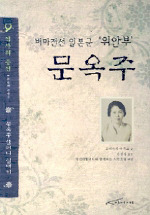
버마전선 일본군 위안부 문옥주 문옥주 할머니 일대기 역사의 증언 두번째 이야기 모리카와 마치코 지음 김정성 옮김 2005년 08월 08일 출간
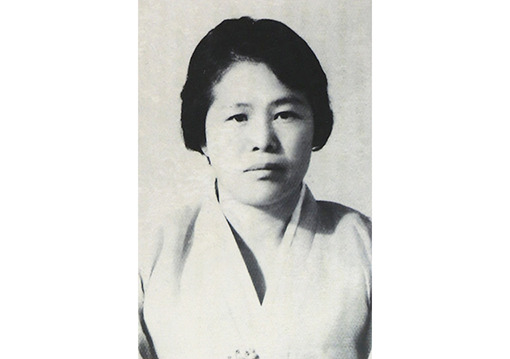
▲ Mun Ok-chu
“Myself as a comfort woman for Tate Division deployed in Burma” by Mun Oku-chu (published August 2005)
(In Mandalay, Burma) page 63 The soldiers and we had the same thoughts, that is, we must work hard for our emperor. The soldiers gave up their wives, children and their own lives. Knowing how they felt, I did my best to solace them by having conversation with them.
page 68 I prayed for safety of Ichiro Yamada. After two or three of months, the troop unit to which Yamada belonged returned from the front. Yamada returned in good health. He immediately came to the comfort station. He said “I, private first class soldier Yamada, have just come back from the front.” Yamada gave a salute to me. We hugged in full of joy. Such a day was so special that the comfort station owner Matsumoto (a Korean from Daegu) closed business for the day. The comfort station was full of excitement, and we, comfort women, contributed 1 yen per woman to hold a big party for them.
page 75 I saved a considerable amount of money from tips. So I asked a clerical staff whether or not I could have a saving account and put the money in the account. His reply was positive. I knew that all the soldiers put their earnings in the saving accounts in the field post office, so I decided to put my money in the saving account. I asked a soldier to make a personal seal and put 500 yen in the account. I got my savings passbook and found 500 yen written on the passbook. I became the owner of the savings passbook for the first time in my life. I worked in Daegu as a nanny and a street seller from the childhood but I remained poor no matter how hard I worked. I could not believe that I could have so much money in my saving account. A house in Daegu cost 1,000 yen at the time. I could let my mother have an easy life. I felt very happy and proud. The savings passbook became my treasure.
page 98 Ichiro Yamada came to see me once a week and I was in a great mood on that day from the morning. But if he did not show up on his once a week holiday, I became so worried wondering if he was killed by the enemy that I could not work properly. He made me worry so much.
(In Rangoon, Burma) pages 106~107 I was able to have more freedom in Rangoon than before. Of course, not completely free but I could go out once a week or twice a month with permission from the Korean owner. It was fun to go shopping by rickshaw. I can’t forget the experience of shopping in a market in Rangoon. There were lots of jewelry shops because many jewels were produced in Burma, and ruby and jade were not expensive. One of my friends collected many jewels. I thought I should have a jewel myself, so I went and bought a diamond.
page 107 I often went to see Japanese movies and Kabuki plays in which players came from the mainland Japan. I enjoyed watching players change costumes many times and male players portray women’s roles. I became a popular woman in Rangoon. There were a lot more officers in Rangoon than near the frontlines, so I was invited to many parties. I sang songs at parties and received lots of tips.
(In Saigon, Vietnam) pages 115~118 It was finally time to return home. I went to Saigon via Thailand. The ship was to depart from Saigon. Then Tsubame said “I had a nightmare in the morning about my mother vomiting blood. I am afraid that something unlucky will happen, so I will not return to Korea.” Hiroko, Kifa and Hifumi agreed with Tsubame saying “We will not go back to Korea, either.”
page 120 When I went to a cabaret where Japanese military men hung out, navy pilots were there. Some of them asked me “Why are you still here?” I replied “I am still here because I don’t want to go home. I want to go back to Rangoon.”
page 121 I put on a pair of high heels, a green coat and carried an alligator leather handbag. I swaggered about in a fashionable dress. No one could guess that I was a comfort woman. I felt so happy and proud.
(Back In Rangoon) page 123 A military man came on a bicycle and asked me “Hi Yoshiko, can you ride a bicycle?” I replied “No, I can’t.” He asked “Would you like to learn how to ride?” I learned with pleasure. I rode it smoothly through the town of Rangoon. I didn’t see any other women on bicycles. People on the street looked back at me. It was fun for me to go to the town of Rangoon. I talked with people in Burmese, Japanese and Korean. I had no difficulty communicating when I shopped.
page 126 I killed a non-commissioned officer who was drunk and held the sword against me. I won acquittal as legitimate self-defense, and many military men were pleased with that court decision.
page 137 I withdrew 5,000 yen from my saving account and sent it to my mother.
_________________________________________

Mun Ok-ju worked in Burma during the period of two years and three months between June 1943 and September 1945. She accumulated total savings of 26,145 yen in deposits at the military post office (Japan’s post office has banking functions). With interest, she earned 50,000 yen from her business. In the 1940s, 5000 yen would have been enough to purchase a house in Tokyo.
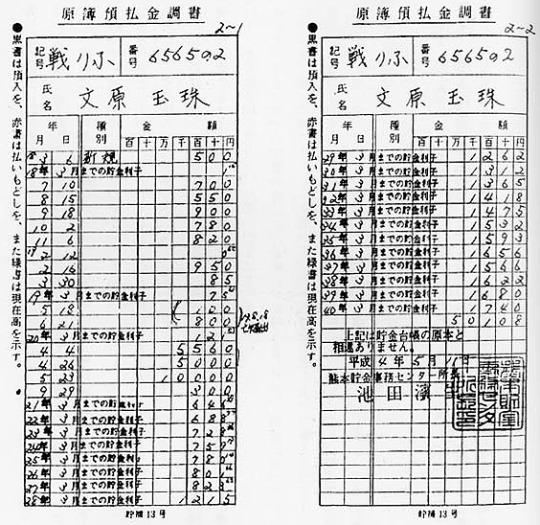
http://scholarsinenglish.blogspot.jp/2014/10/former-korean-comfort-woman-mun-oku.html
____________________________
Psychological Terrorism by The Unification Church at Cheongpyeong
Understanding Sun Myung Moon’s attitude to sex by taking a look at Korean history
Almost all these Comfort Station managers / owners were Korean
Koreans who experienced the Japanese annexation of Korea explain some facts
The Comfort Women controversy Contents of the webpage: 1. Meet Miki Dezaki, Director of the film, Shusenjo: The Main Battleground Of The Comfort Women Issue. 2. Thousands of Korean men and women tricked, kidnapped or forcibly abducted Korean girls to be ‘comfort women’. Statistical Yearbook of the Governor-General of Korea, from 1931-1943. 3. U.S. military documents featuring Korean POW testimony discovered at U.S. National Archives 4. Korean testimony documents highlight ethnic and gender discrimination under Japanese colonial rule 5. “The Comfort Women” (2008) book by Professor C. Sarah Soh (352pp) 6. “Comfort Women of the Empire” the battle over colonial rule and memory (2014) 帝国の慰安婦 植民地支配と記憶の闘い by Professor Park Yu-ha, 박유하, 朴裕河 (336pp) 7. Mun Ok-chu’s memoir 8. Chart of Comfort Station managers, revealing they were Korean 9. The Korean “Comfort Station Manager’s Diary” 10. Comfort Women Urgently Wanted – Ads in Korean newspapers 11. Comfort Women rescued by Japanese military police 12. Kim Tŏk-chin was recruited by Koreans at 17 to be a ‘comfort woman’ Various historical documents and oral histories 13. In 1965 Japan gave $800 million as reparations for Korean occupation 14. Military commentator Ji Man-won raised “fake comfort women” question
Footnotes 1. Interview with Professor C. Sarah Soh 2. Extract from a presentation by Professor Soh 3. Behind the Comfort Women Controversy: How Lies Became Truth by Professor Nishioka Tsutomu 4. No Organized or Forced Recruitment: Misconceptions About Comfort Women and the Japanese Military by Hata Ikuhiko Professor Emeritus, Nihon University 5. GSOMIA lives, but what’s next for Japan and South Korea ties?
____________________________________________
Japan gave $800 million in 1965 as reparations for Korean occupation
The Japanese government supported Korea with $800million in 1965, $400m in 1983 and over $10 billion in 1997.
The Japanese Role in Korea’s Economic Development
“About 100 Korean women were abducted by Korean prostitution brokers but were rescued by the Japanese military police.”
Japanese woman recruited by the Unification Church and sold to an older Korean farmer
6,500 Japanese women missing from Sun Myung Moon mass weddings
6 notes
·
View notes
Text
How did Literary Theory came to shape?
Comprehension of literary theory many a times begets a question that what was the body of theory about literature that has existed from centuries as an underpinning for the study of literature? The answer to this question can be traced from 4th century BC when Aristotle had set the ball rolling to study literature through his Poetics. In this piece of work, Aristotle renders a defining word for the genre ‘tragedy’ while maintaining that literature is about character and the curtain that hides ‘what a character is’ is removed through his actions. Tragedy, as he puts it, should stimulate the emotions of pity and fear, which can be put as sympathy for and empathy with the scrape of the protagonist, which cause a resultant factor by dint of amalgamation of these emotions, namely ‘catharsis’ whereby these emotions are exercised as the audience identify themselves with the predicament of the central character.
Now, the second milestone in the track so instigated was embedded by Sir Philip Sydney. He belonged to a religious age which was chary of accepting any kind of fiction and poetry, and it had so framed its beliefs that it would identify these practices of writing as evil, the work of the devil. In such an age he took a valorous step by letting his work Apology for Poetry (1580) see the light of the day. He was bent to stretch the horizons of the definition of literature that was first rendered by the Latin poet Ovid (43 BC- AD 17), which is docere delictendo – to teach by delighting. Sydney also quotes Horace (65 – 8 BC) to the effect that a poem is ‘a speaking picture, with this end, to teach and delight’. The study of literature, here, renders a central position to receiving of pleasure unlike philosophy which is uplifting but do not allow space for fun. Sydney’s aim was trailblazing; he wanted to distinguish literature from other forms of writing on the rationale that literature’s primary purport is rendering pleasure to the reader, and any moral or didactic element is either subordinate to it or at least unlikely to succeed without it.
Now, here comes the time for the third milestone to be cognised. This step towards the evolution of theory had been taken by Samuel Johnson way down in time, in the eighteenth century. He marks the commencement of the tradition of practical criticism in English, since he is the first one to offer a detailed commentary on the work of a single author. His Lives of the Poets and Prefaces to Shakespeare can be viewed as majorly contributing to his idea stated above. Prior to Johnson it was only the Bible and equivalent books of other religions that were subjected to such an intense scrutiny.
The fourth milestone on this road was embedded by the major thriving of critical theory in the works of the romantic poets, namely William Wordsworth, S. T. Coleridge, John Keats and P. B. Shelley. One of the indispensible contributions in this regard is Wordsworth’s Preface to Lyrical Ballads which blends high literature and popular literature, as it encapsulates literary ballads constructed on the model of the popular oral ballads of ordinary country people. It renders space for the new idea that poetic language should be much like the language of prose avoiding the conventions of diction and verbal structure that had held dominion for so long. It also drags attention to the issue of the relationship between ‘literature’ and other kinds of writing.
The other essential work from the Romantic era was Coleridge’s “Biographia Literaria”. Much of the space that it occupies explicitly addresses the idea contained in Wordsworth’s Preface. He gainsaid the notion that the language of poetry must strive to become like the language of prose, and the major way to entertain the readers, according to Coleridge, is through the language in which the text is written; it entertains via its fictive qualities which become the source of aesthetic effect.
P. B. Shelley’s A Defence of Poetry (1821) reckons that poetry is essentially engaged with ‘defamiliarisation’, since, according to him, poetry purges from within us the view of familiarity and compels us to feel what we perceive and imagine what we already know. This phenomenal critical document foretells T. S. Eliot’s notion of impersonality put forward in his essay, ‘Tradition and the Individual Talent’ (1919). It also gives a hint of Freud’s idea of mind as made up of conscious and unconscious.
The concept of unconscious is very often found in Romanticism and is implicit in everything written about poetry by another key figure, John Keats. He did not formally write about literary theory but reflects on poetry in his letters, for instance in a letter to Bailey of 22 November, 1817, he writes that the simple imaginative mind may have its awards in the repetition of its own silent working coming continually on the spirit with a fine suddenness. Here, the silent working of the mind is the unconscious and the spirit into which it erupts is the conscious. Keats’ notion of negative capability also records unconscious as paramount.
After the Romantics the next milestone was embedded by the work of mid and late Victorians: George Eliot, Matthew Arnold and Henry James.
The focus on the concept of ‘close-reading’ in the 1920s had partly popped up from the works of Matthew Arnold. He remained a crucial figure in the history of English criticism.
He feared that the atrophy of religion would leave a cleaved society with no common system of beliefs and values, and this would be a potentially disastrous consequence. Thus, he came up with a solution that literature can be a possible replacement for religion in this regard and also weened that the middle classes on whom the responsibility of democracy majorly fell, had been debased by materialism and philistinism. So this became the apt timing for the critic to jump in and help people in cognising the best that has been known and thought in the world and therefore, it enlarged their capacities to identify and approbate the canon of great works that had been carved out of the wisdom of the ages. Arnold seems to be bringing to sunshine the advocacy that he had for the amateur. According to him, if one has not read everything but have read the best and is able to pen down its qualities, then he can have the confidence to write and reach a true judgement on it. This veering change announced a direct relationship between the reader and the great literary works/writers.
His momentous thoughts are found in the essay titled The Function of Criticism at the Present Time and The Study of Poetry. He has brought to prominence the conviction that literature must remain disinterested that is, politically detached and uncommitted to any specific action, and the motive behind literary criticism is to attain pure and disinterested knowledge which in his terms is to see the object as in itself it really is.
His key literary-critical device is the idea of ‘touchstone’ where he advocates that there must always be in mind the lines and expressions of the great masters and they must be applied as a touchstone in framing critical appreciations of other literary works in order to render a ‘real’ rather than a ‘historic’ or a ‘personal’ stance.
The next salient contribution in the canon of critical ideas has been made by T. S. Eliot, and his prime formulations are:
1. Dissociation of Sensibility – Eliot coined this term in his review article on Herbert Grierson’s edition of The Metaphysical Poets in the seventeenth century where he backed the idea that thought and feeling must be separate.
2. Poetic Impersonality �� Eliot developed this term in his two-part essay, Tradition and the Individual Talent. This term can be viewed as his way of deflecting the contemporary thinking about poetry from the ideas of originality and self-expression which were raised to prominence by Romanticism. More than perceiving poetry as a mere outflow of emotions and personal experience, he saw it as transcending of the individual by a sense of tradition which spoke through, and is transmitted by, the individual poet. Hence, there is a fine line of distinction between the mind of the individual, the experiencing human being and the voice which speaks to the readers.
3. Objective Correlative – This is a notion developed in the essay On Hamlet, which is the encapsulation of English empiricist attitudes. According to objective correlative, the best way to show emotions the doors in art is through gesture, action or concrete symbolism rather than approaching it implicitly. This runs, perhaps, parallel with the ancient distinction made by Plato between mimesis and diegesis.
Finally comes in the last name on the list which is F. R. Leavis, the most influential British critic prior to the theory movement. He also, like Arnold, saw that the study and appreciation of literature is a pre-condition to the health of society. For him, the abstract thoughts were insignificant and he wanted to look for a system which would by-pass fixed criteria. Like Arnold, he turned down attempts to politicise either literature or criticism implicitly. But, he differed from Arnold too as he took the past great writers more or less for granted. He composed essays, radiating the essence of his method, which hit the reputation of some major established figures.
Leavis began as an admirer of T. S. Eliot’s critical works but he steered clear of shaping out critical vocabulary and deployed terms and phrases which already had set meanings. For him, what makes a work worthy is its conduciveness to life and vitality. In 1932 he founded an important journal called Scrutiny along with his wife, Q. D. Leavis, which they produced together for twenty-one years. As the title itself suggests, it extended the ‘close-reading’ method beyond poetry to novels and other materials. He can be reckoned as a combination of Samuel Johnson and Matthew Arnold because he offered former’s moralism and the latter’s thoughts concerning society.
4 notes
·
View notes
Link
Can you believe ...?
Perhaps no question has been repeated more times in reaction to more events this year than that one.
The most recent major outrage in the Jewish community, now several news cycles behind us, came on the Shabbat before Yom Kippur—the holiest day in the Jewish calendar—when many American Jews seemed dumbfounded by what was to me predictable news: Alexandria Ocasio-Cortez, progressive superstar, had pulled out of an event honoring Yitzhak Rabin, the Israeli prime minister assassinated because of his efforts to make peace with the Palestinians. Rabin was, as Bill Clinton said at his funeral, “a martyr for his nation’s peace.”
…
But it wasn’t AOC who was mixed up. The savvy politician had read the room and was sending a clear signal about who belongs in the new progressive coalition and who does not. The confusion—and there seems to be a good deal of it these days—is among American Jews who think that by submitting to ever-changing loyalty tests they can somehow maintain the old status quo and their place inside of it.
Did you see that the Ethical Culture Fieldston School hosted a speaker that equated Israelis with Nazis? Did you know that Brearley is now asking families to write a statement demonstrating their commitment to “anti-racism”? Did you see that Chelsea Handler tweeted a clip of Louis Farrakhan? Did you see that protesters tagged a synagogue in Kenosha with “Free Palestine” graffiti? Did you hear about the march in D.C. where they chanted “Israel, we know you, you murder children too”? Did you hear that the Biden campaign apologized to Linda Sarsour after initially disavowing her? Did you see that Twitter suspended Bret Weinstein’s civic organization but still allows the Iranian ayatollah to openly promote genocide of the Jewish people? Did you see that Mayor Bill de Blasio scapegoated “the Jewish community” for the spread of COVID in New York, while defending mass protests on the grounds that this is a “historic moment of change”?
Listen, it’s been a hell of a year. We all have a lot going on, much of it unnerving and some of it dire. Moreover, many of these stories only surface on places like Twitter; they don’t make it into the pages of The New York Times or your friends’ Facebook feeds, which is where most Americans get their news these days. Reporters don’t cover these stories adequately, contextualizing them, telling readers which ones are true and which ones aren’t, which ones matter and which ones don't.
So it makes sense that many smart, well-intentioned people are confused. Or rather: Looking for someone to explain why an emerging movement that purports to advance the ideals they have always supported—fairness, justice, righting historical wrongs—feels like it is doing the opposite.
…
To understand the enormity of the change we are now living through, take a moment to understand America as the overwhelming majority of its Jews believed it was—and perhaps as we always assumed it would be.
It was liberal.
Not liberal in the narrow, partisan sense, but liberal in the most capacious and distinctly American sense of that word: the belief that everyone is equal because everyone is created in the image of God. The belief in the sacredness of the individual over the group or the tribe. The belief that the rule of law—and equality under that law—is the foundation of a free society. The belief that due process and the presumption of innocence are good and that mob violence is bad. The belief that pluralism is a source of our strength; that tolerance is a reason for pride; and that liberty of thought, faith, and speech are the bedrocks of democracy.
The liberal worldview was one that recognized that there were things—indeed, the most important things—in life that were located outside of the realm of politics: friendships, art, music, family, love. This was a world in which Antonin Scalia and Ruth Bader Ginsburg could be close friends. Because, as Scalia once said, some things are more important than votes.
Crucially, this liberalism relied on the view that the Enlightenment tools of reason and the scientific method might have been designed by dead white guys, but they belonged to everyone, and they were the best tools for human progress that have ever been devised.
Racism was evil because it contradicted the foundations of this worldview, since it judged people not based on the content of their character, but on the color of their skin. And while America’s founders were guilty of undeniable hypocrisy, their own moral failings did not invalidate their transformational project. The founding documents were not evil to the core but “magnificent,” as Martin Luther King Jr. put it, because they were “a promissory note to which every American was to fall heir.” In other words: The founders themselves planted the seeds of slavery’s destruction. And our second founding fathers—abolitionists like Frederick Douglass—made it so. America would never be perfect, but we could always strive toward building a more perfect union.
I didn’t even know that this worldview had a name because it was baked into everything I came into contact with—my parents’ worldviews, the schools they sent me to, the synagogues we attended, the magazines and newspapers we read, and so on.
…
No longer. American liberalism is under siege. There is a new ideology vying to replace it.
No one has yet decided on the name for the force that has come to unseat liberalism. Some say it’s “Social Justice.” The author Rod Dreher has called it “therapeutic totalitarianism.” The writer Wesley Yang refers to it as “the successor ideology”—as in, the successor to liberalism.
…
The new creed’s premise goes something like this: We are in a war in which the forces of justice and progress are arrayed against the forces of backwardness and oppression. And in a war, the normal rules of the game—due process; political compromise; the presumption of innocence; free speech; even reason itself—must be suspended. Indeed, those rules themselves were corrupt to begin with—designed, as they were, by dead white males in order to uphold their own power.
…
Critical race theory says there is no such thing as neutrality, not even in the law, which is why the very notion of colorblindness—the Kingian dream of judging people not based on the color of their skin but by the content of their character—must itself be deemed racist. Racism is no longer about individual discrimination. It is about systems that allow for disparate outcomes among racial groups. If everyone doesn’t finish the race at the same time, then the course must have been flawed and should be dismantled.
…
In fact, any feature of human existence that creates disparity of outcomes must be eradicated: The nuclear family, politeness, even rationality itself can be defined as inherently racist or evidence of white supremacy, as a Smithsonian institution suggested this summer. The KIPP charter schools recently eliminated the phrase “work hard” from its famous motto “Work Hard. Be Nice.” because the idea of working hard “supports the illusion of meritocracy.” Denise Young Smith, one of the first Black people to reach Apple’s executive team, left her job in the wake of asserting that skin color wasn’t the only legitimate marker of diversity—the victim of a “diversity culture” that, as the writer Zaid Jilani has noted, is spreading “across the entire corporate world and is enforced by a highly educated activist class.”
The most powerful exponent of this worldview is Ibram X. Kendi. His book “How to Be an Antiracist” is on the top of every bestseller list; his photograph graces GQ; he is on Time’s most influential people of the year; and his outfit at Boston University was recently awarded $10 million from Twitter CEO Jack Dorsey.
…
And just in case moral suasion is ineffective, Kendi has backup: Use the power of the federal government to make it so. “To fix the original sin of racism,” he wrote in Politico, “Americans should pass an anti-racist amendment to the U.S. Constitution that enshrines two guiding anti-racist principals [sic]: Racial inequity is evidence of racist policy and the different racial groups are equals.” To back up the amendment, he proposes a Department of Anti-Racism. This department would have the power to investigate not just local governments but private businesses and would punish those “who do not voluntarily change their racist policy and ideas.” Imagine how such a department would view a Jewish day school, which suggests that the Jews are God’s chosen people, let alone one that teaches Zionism.
Kendi—who, it should be noted, now holds Elie Wiesel’s old chair at Boston University—believes that “to be antiracist is to see all cultures in their differences as on the same level, as equals.” He writes: “When we see cultural difference we are seeing cultural difference—nothing more, nothing less.” It’s hard to imagine that anyone could believe that cultures that condone honor killings of unchaste young women are “nothing more, nothing less” than culturally different from our own. But whether he believes it or not, it’s obvious that embracing such relativism is a highly effective tool for ascension and seizing power.
It should go without saying that, for Jews, an ideology that contends that there are no meaningful differences between cultures is not simply ridiculous—we have an obviously distinct history, tradition and religion that has been the source of both enormous tragedy as well as boundless gifts—but is also, as history has shown, lethal.
By simply existing as ourselves, Jews undermine the vision of a world without difference. And so the things about us that make us different must be demonized, so that they can be erased or destroyed: Zionism is refashioned as colonialism; government officials justify the murder of innocent Jews in Jersey City; Jewish businesses can be looted because Jews “are the face of capital.” Jews are flattened into “white people,” our living history obliterated, so that someone with a straight face can suggest that the Holocaust was merely “white on white crime.”
This is no longer a fringe view. As the philosopher Peter Boghossian has noted: “This ideology is the dominant moral orthodoxy in our universities, and has seeped out and spread to every facet of American life— publishing houses, tech, arts, theater, newspapers, media,” and, increasingly, corporations. It has not grabbed power by dictates from above, but by seizing the means of sense-making from below.
Over the past few decades and with increasing velocity over the last several years, a determined young cohort has captured nearly all of the institutions that produce American cultural and intellectual life. Rather than the institutions shaping them, they have reshaped the institutions. You don’t need the majority inside an institution to espouse these views. You only need them to remain silent, cowed by a fearless and zealous minority who can smear them as racists if they dare disagree.
It is why California attempted to pass an ethnic studies curriculum whose only mention of Jews was to explain how they, along with Irish immigrants, were invited into whiteness.
It is why those who claim to care about diversity and inclusion don’t seem to care about the deep-seated racism against Asian Americans at schools like Harvard.
It is why a young Jewish woman named Rose Ritch was recently run out of the USC student government. Ms. Ritch stood accused of complicity in racism because, following the Soviet lie, to be a Zionist is to be nothing less than a racist. Her fellow students waged a campaign to hound her out of her position: “Impeach her Zionist ass,” they insisted.
It is why the Democratic Socialists of America, the emerging power center of the Democratic Party in New York, sent a questionnaire to New York City Council candidates that included a pledge not to travel to Israel.
It is why Tamika Mallory, an outspoken fan of Louis Farrakhan, gets the glamour treatment in a photoshoot for Vogue.
And this is why AOC, the standard bearer of America’s new left, didn’t think Yitzhak Rabin was worth the political capital, but goes out of her way, a few days later, to praise the Black Panthers. She is the harbinger of a political reality in which Jews will have little power.
It does not matter how progressive you are, how vegan or how gay, how much you want universal health care and pre-K and to end the drug war. To believe in the justness of the existence of the Jewish state—to believe in Jewish particularism at all—is to make yourself an enemy of this movement.
…
If you’re nearing the end of the essay wondering why this hasn’t been explained to you before, the answer is because, yet again, we find ourselves in another moment in Jewish history at a time of great need and urgency with communal leadership who, with rare exception, will not address the danger.
I understand why people have been blind to this. Life has been good—exceedingly good—for American Jews for half a century. Many older communal leaders seem to lack the moral imagination to see this threat. It’s also hard for anyone to hear the words: They’re just not that into you.
So when I try to discuss this with many Jews in leadership positions, what I face is either boomer-esque entitlement—a sense that the way the world worked for them must be the way it will always work—or outright resistance. Oh please, wokeness isn’t important anywhere but in silly Twitter microclimates. When you explain that no, in fact, this ideology has taken over universities, publishing houses, the media, museums and is now making quick work of corporate America, you hit another roadblock: Isn’t this just righting some historical injustices? What could go wrong? You then have to explain what could go wrong—what is already going wrong—is that it is ruining the lives of regular, good people, and the more institutions and companies fall prey to it, the more lives it will ruin.
…
Last month, I participated in a Zoom event attended by several major Jewish philanthropists. After briefly talking about my experience at The New York Times, I noted that if they wanted to understand what happened to me, they needed to appreciate the power of that new, still-nameless creed that has hijacked the paper and so many other institutions essential to American life. I’ve been thinking about what happened next ever since.
One of the funders on the call launched into me, explaining that Ibram X. Kendi’s work was vital, and portrayed me as retrograde and uncool for opposing the ideology du jour. Because this person is prominent and powerful enough to send signals that others in the Jewish world follow, the comments managed to both sideline me and stun almost everyone else into silence.
These people may be the most enraging: those with the financial security to oppose this ideology and demur, so desperate to be seen as hip; for their children to keep their spots at the right prep schools; so that they can be seated at the right tables at the right benefits; so that they are honored at Brown or Harvard; so that business does well enough that they can renovate their house in Aspen or East Hampton. Desperate to remain in good odor with the right people, they are willing to close their eyes to what is coming for the rest of us.
Young Jews who grasp the scope of this problem and want to fight it thus find themselves up against two fronts: their ideological enemies and their own communal leadership. But it is among this group—people with no social or political capital to hoard, some of them not even out of college—that I find our community’s seers. The dynamic reminds me of the one Theodor Herzl faced: The communal establishment of his time was deeply opposed to his Zionist project. It was the poorer, younger Jews—especially those from Russia—who first saw the necessity of Zionism’s lifesaving vision.
Funders and communal leaders who are falling over themselves to make alliances with fashionable activists and ideas enjoy a decadent indulgence that these young proud Jews cannot afford. They live far from the violence that affects Jews in places like Crown Heights and Borough Park. If things go south in one city, they can take refuge in a second home. It may be cost-free for the wealthy to flirt with an ideology that suggests abolishing the police or the nuclear family or capitalism. But for most Jews and most Americans, losing those ideas comes with a heavy price.
1 note
·
View note
Link
copy & pasted under the read more in order to have a local copy.
A Brief His and Herstory of Butch And Femme
BY: JEM ZERO 16 DEC 2017
When America’s LGBTQ+ folk started coming out of the closet in the 1950s, the underground scene was dominated by working class people who had less to lose if they were outed. Butch/femme presentation arose as a way for lesbians to identify each other, also serving as a security measure when undercover cops tried to infiltrate the local scenes. Butch women exhibited dapper and dandy aesthetics, and came to be known for being aggressive because they took protective roles during raids and other examples of homophobic violence. The image of the butch lesbian became a negative stereotypes for lesbians as a whole, leaving out femme lesbians, who are (pretty insultingly) considered undetectable as lesbians due to their feminine presentation.
In modern times there’s less need for strict adherence to these roles; instead, they become heritage. A great deal of political rebellion is wrapped up in each individual aesthetic. Butch obviously involves rejecting classically feminine gender expectations, while femme fights against their derogatory connotations.
But while butch/femme has been a part of lesbian culture, these terms and identities are not exclusive to queer women. Many others in the LGBTQ community utilize these signifiers for themselves, including “butch queen” or “femme daddy.” Butch and femme have different meanings within queer subcultures, and it’s important to understand the reasons they were created and established.
The Etymology
The term “lesbian” derives from the island on which Sappho lived—if you didn’t already guess, she was a poet who wrote extensively about lady-lovin’. Before Lesbos lent its name to lesbians, the 1880s described attraction between women as Sapphism. In 1925, “lesbian” was officially recorded as the word for a female sodomite. (Ick.) Ten years before that, “bisexual” was defined as "attraction to both sexes."
In upcoming decades, Sapphic women would start tearing down the shrouds that obscured the lives of queer women for much of recorded history. Come the ‘40s and ‘50s, butch and femme were coined, putting names to the visual and behavioral expression that could be seen in pictures as early as 1903. So, yeah—Western Sapphic women popularized these terms, but the conversation doesn’t end there, nor did it start there.
Before femme emerged as its own entity, multiple etymological predecessors were used to describe gender nonconforming people. Femminiello was a non-derogatory Italian term that referred to a feminine person who was assigned male—this could be a trans woman, an effeminate gay man, or the general queering of binarist norms. En femme derives from French, and was used to describe cross-dressers.
Butch, first used in 1902 to mean "tough youth," has less recorded history. Considering how “fem” derivatives were popularized for assigned male folks, one might attribute this inequality to the holes in history where gender-defying assigned female folks ought to be.
The first time these concepts were used to specifically indicate women was the emergence of Sapphic visibility in twentieth century. This is the ground upon which Lesbian Exclusivism builds its tower, and the historical and scientific erasure of bisexual women is where it crumbles. Seriously, did we forget that was a thing?
The assumption that any woman who defies gender norms is automatically a lesbian relies on the perpetuation of misogynist, patriarchal stereotypes against bisexual women. A bisexual woman is just as likely to suffer in a marriage with a man, or else be mocked as an unlovable spinster. A woman who might potentially enjoy a man is not precluded from nonconformist gender expression. Many famous gender nonconforming women were bisexual—La Maupin (Julie d'Aubigny), for example.
Most records describing sexual and romantic attraction between women were written by men, and uphold male biases. What happens, then, when a woman is not as openly lascivious as the ones too undeniably bisexual to silence? Historically, if text or art depicts something the dominant culture at the time disagrees with, the evidence is destroyed. Without voices of the Sapphists themselves, it’s impossible to definitively draw a line between lesbians and bisexuals within Sapphic history.
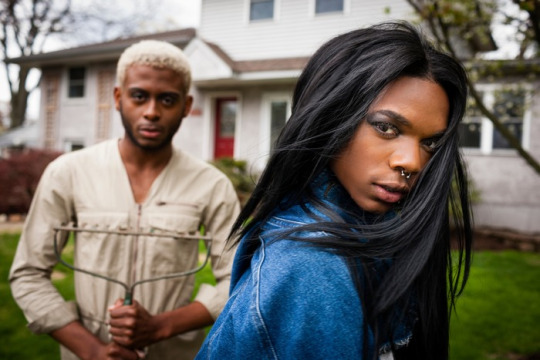
Beyond White Identities
Another massive hole in the Lesbian Exclusivist’s defenses lies in the creeping plague that is the Mainstream White Gay; it lurks insidiously, hauling along the mangled tatters of culture that was stolen from Queer and Trans People of Colour (QTPOC). In many documents, examples provided of Sapphic intimacy are almost always offered from the perspective of white cis women, leaving huge gaps where women of color, whether trans or cis, and nonbinary people were concerned. This is the case despite the fact that some of the themes we still celebrate as integral to queer culture were developed by Black and Latinx LGBTQ+ folk during the Harlem Renaissance, which spanned approximately from 1920 to 1935.
A question I can’t help but ask is: Where do queer Black, Indigenous, and other People of Color fit into the primarily white butch/femme narrative? Does it mean anything that the crackdown on Black queer folk seemed to coincide with the time period when mainstream lesbianism adopted butch and femme as identifiers?
Similar concepts to butch/femme exist throughout the modern Sapphic scene. Black women often identify as WLW (Women-Loving-Women), and use terms like “stud” and “aggressive femme.” Some Asian queer women use “tomboy” instead of butch. Derivatives and subcategories abound, sometimes intersecting with asexual and trans identities. “Stone butch” for dominant lesbians who don’t want to receive sexual stimulation; “hard femme” as a gender-inclusive, fat-positive, QTPOC-dominated political aesthetic; “futch” for the in-betweenies who embody both butch and femme vibes. These all center women and nonbinary Sapphics, but there’s still more.
Paris is Burning, a documentary filmed about New York City ball culture in the 1980s, describes butch queens among the colourful range of identities prevalent in that haven of QTPOC queerness. Despite having a traditionally masculine physique, the gay male butch queen did not stick to gender expectations from straight society or gay culture. Instead, he expertly twisted up his manly features with women’s clothing and accessories, creating a persona that was neither explicitly masculine nor feminine.
Butch Queens Up in Pumps, a book by Marlon M. Bailey, expounds upon their presence within inner city Detroit’s Ballroom scene, its cover featuring a muscular gay man in a business casual shirt paired with high heels. Despite this nuance, butch remains statically defined as a masculine queer woman, leaving men of color out of the conversation.
For many QTPOC, especially those who transcend binary gender roles, embracing the spirit of butch and femme is inextricable with their racial identity. Many dark-skinned people are negatively portrayed as aggressive and hypermasculine, which makes it critical to celebrate the radical softness that can accompany femme expressions. Similarly, the intrinsic queerness of butch allows some nonbinary people to embrace the values and aesthetics that make them feel empowered without identifying themselves as men.

Butch, Femme, and Gender
It’s pretty clear to me that the voices leading the Lesbian Exclusive argument consistently fail to account for where butch and femme have always, in some form, represented diverse gender expression for all identities.
‘Butch’ and ‘femme’ began to die out in the 1970s when Second Wave Feminism and Lesbian Separatism came together to form a beautiful baby, whom they named “Gender Is Dead.” White, middle class cis women wrestled working class QTWOC out of the limelight, claiming that masculine gender expression was a perversion of lesbian identity. The assassination attempt was largely unsuccessful, however: use of these identifiers surged back to life in the ‘80s and ‘90s, now popularized outside of class and race barriers.
Looking at all this put together, I have to say that it’s a mystery to me why so many lesbians, primarily white, believe that their history should take precedence over… everyone else that makes up the spectrum of LGBTQ+ experiences, even bi/pan Sapphics in same-gender relationships. If someone truly believes that owning butch/femme is more important than uniting and protecting all members of the Sapphic community from the horrors of homophobic and gendered oppression, maybe they’re the one who shouldn’t be invited to the party.
As a nonbinary lesbian, I have experienced my share of time on the flogging-block. I empathize strongly with the queer folks being told that these cherished identities are not theirs to claim. Faced with this brutal, unnecessary battle, I value unity above all else. There’s no reason for poor trans women, nonbinary Black femmes, bisexual Asian toms, gay Latino drag queens, or any other marginalized and hurting person to be left out of the dialogue that is butch and femme, with all its wonderful deconstructions of mainstream heteronormative culture.
It is my Christmas wish that the Lesbian Exclusivist Tower is torn down before we open the new chapter in history that is 2018. Out of everything the LGBTQ+ community has to worry about already, petty infighting shouldn’t be entertained—especially when its historical foundation is so flimsy. Queering gender norms has always been the heart of butch/femme expression, and that belongs to all of us.
#lesbian#butch#femme#bi-#queer history#fenpost#wlw#sapphic#also#nlw#cause the author is a nb lesbian
390 notes
·
View notes
Text
Unique Places to Get Married in Maryland - A Guide

One of the hardest things to do when planning your special day is to spend hours scouring the internet looking for a unique, classy, and un-used location for your wedding. I've spent the past two days in searching for that oh so elusive perfect spot. I'm going to save you all the trouble I went through and compile all the spots I found through obscure Google searches and message boards and put these locations in one place. Welcome to your one stop shop for unique wedding locations all over Maryland. For your convince I've put them into genre such as "Castle Theme", "Relaxed Theme", etc. so if you're really in a knot, you don't have to spend your whole day looking when you could be finding the perfect pair of shoes to go with your dress. Here we go:
Castles:
Cloisters Castle: This private home that was commissioned and completed in a twenty seven year span screams with uniqueness. From the exterior built of Butler gold and gray stone, gables taken from a medieval house in France as well as medallions from a 16th century Venetian home, it's a work of architectural brilliance. Located in Luthersville, MD this venue is surrounded by sixty acres of trees and a lovely garden. Its insides are furnished with authentic medieval pieces and antique furniture. The fireplace was even commissioned to be built from an antique chest carved with Renaissance figures. Famously, it was the site of actor Will Smith's and Jada Pinkett's wedding in 1998 but that hasn't put a damper on the delightful and unforgettable atmosphere the house creates. Either the outside or the inside can be made available and there is only one event per day, allowing your day to be uninterrupted in its magic. The fee for rental allows for up to ten hours on the grounds and more time can negotiated through the contract via an extra hour's fee. The venue comfortably fits 175 guests and as a bonus the staff acts as your wedding planner directing set-up, timing, and valet parking.
Maryvale Castle : Functioning as a preparatory school, Maryvale Castle boasts huge grounds complete with wedding chapel if the bride doesn't envision herself walking down the castle's much talked of grand winding staircase. Built in 1917 in Greenspring Valley, MD, this treasure houses an oak-paneled Great Hall, a solarium, and a bridal suite. A stone manor house sweeping off in both directions takes its influences from Warwick Castle in England with its Gothic arched windows, port cochere, and imposing gray towers. A rental agreement includes four hours of time which includes the rehearsal time and full use of the property. However, because it is still a working school, hours on the weekdays are more restricted than weekends. With an indoor guest capacity of 125 people and an outdoor capacity of 200, this venue is worth the strict appointment-only tour.
Mansions:
Montpelier Mansion: A mansion straight out of a Jane Austin piece, this brick Georgian structure sits on seventy acres of land flanked by dogwood trees. Built between 1781 and 1785 this national historic landmark is open to the public for tours and festivities and once housed George Washington and his wife Martha. It is also home to an uncommonly found 18th century summer house which is beautifully preserved. The maximum capacity inside and outside is somewhat small, eighty-five guests total, but the unique floor plan with crown molding and period furniture lends itself to an opulent and old-fashioned charm all its own. For people set on a Sunday wedding this venue isn't for you as they don't allow rentals on Sundays, however, having free reign over this delicate place is well worth the date change. Located in Laurell this mansion radiates country elegance akin to many a bride's favorite novel, complete with circular stone driveway.
Glenveiw Mansion: Situated in Rockville, MD as part of a Rockville Civic Center Park the house is within the neoclassical tradition sporting pillars and an infinite number of beautiful black shuttered windows looking out over the lawn. The dining room is veiled in class and luxury as are its floor-to-ceiling dark paneled wooden walls and long oval windows. The conservatory shines with old-fashioned chandeliers whose light bounces off the Italian green marble floors. The rest of the house is touched with intricate details pertaining to the period in which it was first built housing a number of turn of the century, one- of- a- kind antiques sure to make any wedding memorable. Maximum capacity for this venue is 225 guests and amount charged allows for two hours of set-up and one hour of clean-up. Some strict drawbacks to possible brides are the impossibilities of seated dining, no cooking allowed on-site, and no red-dyed beverages of any kind.
Stronghold Mansion: On top of Sugarloaf Mountain in Dickerson, MD the completely white mansion with pillars and latticed widow's peak lends itself to the country simplicity surrounding it. The straight lawns emphasize the well designed rock walls that glide around the property housing a variety of elegant but simple flora and fauna normally seen in a country garden. The shimmering, circular lake to the side of the house has large willow trees surrounding it and making a path towards the house itself where the architecture inside matches the outside in its refined gentile decor. A standard contract allows for 7 hours and includes set-up and clean-up times. . Additional hours can be negotiated. Maximum number of guests in attendance is 200 and the rental includes 40 by 57 inch tent over the patio and can be added on to encompass the lake area as well. Parking is limited as there are only 85 spots available and clearly marked by the owners , small shuttle buses are permitted.
Liriodendron Mansion: An 1898 ornate masterpiece encompassed by a landscape dripping with flowers, this antique summer home in Harford County leaves nothing unchecked in your imagination. Whether it's the Grecian old-world architecture built around intricate carvings, urns of flowers and stone pillars, or the wisteria vines that form a canopy over the porch for a otherworldly rehearsal dinner, the house is awash in magic all its own. The Palladian styled mansion reminds guests of a fairyland surrounded by woods and fountains with a variety of romantic stone sculptures throughout the grounds. Maximum capacity is 150 guests outside, 100 guests inside with seating and there are plenty of guests parking. The renter has a choice of 6.5 hrs on weekdays where as on weekends they must choose between both rental times and party times in a wide selection of choices. Wedding rehearsals are extra payment as well as table and chair rental fees, but this is no different from most other venues.
Tudor Place: This home to Martha Washington's late granddaughter, Martha Custic Peter, is bursting at the seams with rich history and warm, comfortable elegance. The house itself was built in 1805 by Dr. William Thorton who was also famous for building the first United States Capital and The Octagon building in Washington, DC. Inside the house there are over one hundred objects belonging to George and Martha Washington and it's all been documented in an archived collection of letters, diaries, books, and photographs. As far as guests, the mansion can hold up to 35 guests for a wedding ceremony and for parties over 35 guests they must pay extra. This venue is for ceremonies only and the reservation includes an hour block of time for that ceremony. They also have their own on sight photography for a fee.
Ceresville Mansion: With a variety of ceremony options to suit any bride as well as an in-house consultant to coordinate everything smoothly, this Mansion comes with superior services. Whether the perfect wedding uses their white Grecian Pergola surrounded by dogwoods in bloom, or the terrace climbing with Ivy and backlit with candles shimmering over the reflecting lily pool, it will be something to remember. The white and black sweeping Cape Cod style home was built in 1888 alongside rivers, hillsides, and a ten acre meadow also open for events. Much of the original architecture as well as the antique furniture and fireplace are still the same as 1888. This venue has everything covered in the rental fee from seven hours of event coordination to all the outside details a catering company would normally provide like linens and a dance floor. Every Thursday evening they also offer an unusual wedding discount for those on a budget and cut the price nearly in half for the same services as a Friday or Saturday wedding event. The venue can provide for up to 200 guests and also gives a complimentary list of Food and Beverage minimum pricing so it is free of confusion and out of the way.
Inns and Taverns: Flower Wall Rental Los Angeles
Slades Inn and Tavern: A Victorian dream painted in lively light blues and dark blues, this Inn sets itself apart with two matching circular turrets, high brick chimneys and a white wrap-around porch that Anne of Green Gables would envy. The laid-back romantic space is in Fredrick, MD a few minutes away from Baltimore. The land is dappled with greenery and horses while the exciting night-life and history of the city are in close proximity. Enjoy an easy day as all the guests are accommodated with places to stay after the reception and perhaps even stay past the ceremony for a honeymoon to enjoy hot air ballooning or a carriage tour. From beginning to end of that extraordinary day, Slade's takes care of everything from "his and hers" massages, bridal party hair and makeup sessions, as well as brunches and teas. Indoor buffet seating is for 100 guests whereas larger parties can be accommodated with tents for seated dinners and dancing for up to 150. Once the party is over, guests too busy having fun can tumble up to their rooms leaving the bride and groom clear and free of worry.
1 note
·
View note
Text
Brilliant history of indigenous North America from Quora
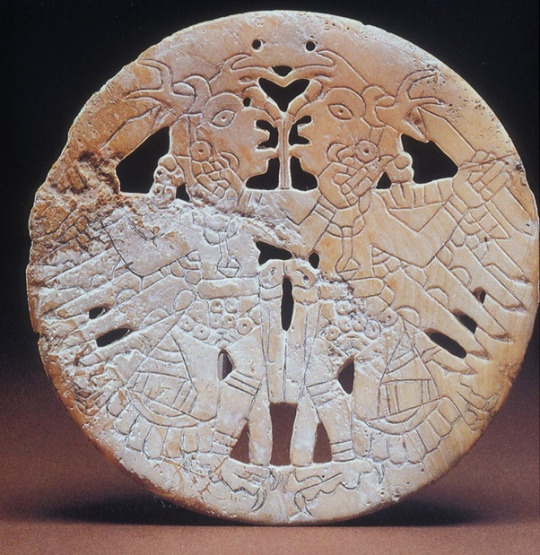

Why did no ancient civilization come up the Mississippi river valley even though it had similar conditions to other river valley civilizations?
Jonathan Hall
, Sapient primate since 1996, enjoys learning about things
Updated Jan 27
· Upvoted by
Roderick White
, PhD Ancient History, University College London (2018)
It really is a pity that even today, despite all the literature, museums and outreach, even the average citizen of the eastern United States is still blissfully unaware of the complex societies whose remnants they often walk or drive right over.
Story time!
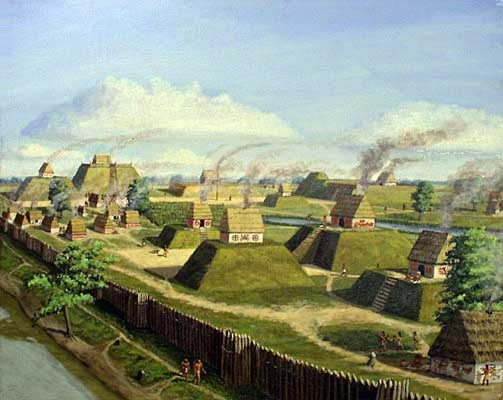
The Eastern Woodlands of the United States has been a nexus for stratified civilization since 3500 B.C. The Mississippi River area was even home to its own independent cradle of agriculture known as the Eastern Agricultural Complex, from which we still have popular vegetables like squash and sunflower. The peoples that farmed these crops have been traditionally termed the “Mound Builders”, so named for their apparent proclivity towards earthworks. The term is a bit dated now, and archaeologists today are able to differentiate specific cultures, but “mound-building peoples” is often still used to describe the cultures in general.
There have been many mound-building societies over the course of North American history. We’ll probably never know the exact political relationships, but we can identify consistencies in material culture and living patterns. The first one that really seems to take off across the board is the Hopewell:
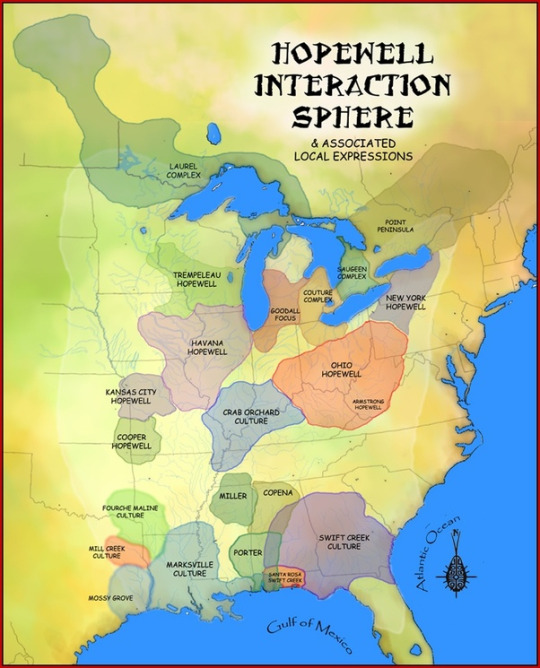
Starting around 100 BC, sites all around the Mississippi start adopting a similar set of traits such as pottery styles, arrowhead techniques and artistic motifs, along with a much more pronounced sense of social stratification. The Hopewell appear to have begun with the Ohio Hopewell, which built upon the stratified Adena culture that existed since 1000 BC on the Ohio River valley, which connects to the Mississippi. The Hopewell greatly proliferate the number of mounds constructed in the Eastern Woodlands and diversify their uses.
One of the most iconic examples of the Hopewell are the Newark Earthworks: a series of interconnected circles, walls and moats that appear to serve as a massive lunar observatory. The Moon’s orbit ‘wobbles’ in relation to the Earth: at one extreme the orbit is rotated one way, and rotated the other way at the other extreme. The point in this cycle where the Moon’s orbital plane reaches its northernmost or southernmost extent before going back to the other is termed the lunar standstill, which produces an effect not unlike the Sun’s solstices. This happens every 18 years, 7 months and almost 10 days. The Newark Earthworks are able to track the Moon’s declination until the next standstill with remarkable precision.
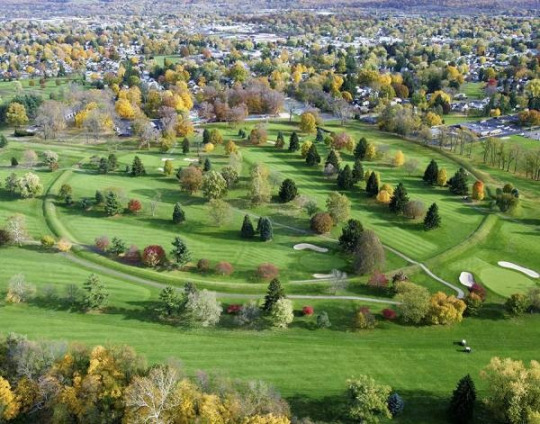
Newark today. A country club still owns parts of the earthworks.
It’s possible that the Ohio Hopewell had such influence over the Eastern Woodlands that they may have started a new religious movement, or perhaps their influence was economical and assimilating their culture was better for business, or people may have simply admired parts of their culture enough to replicate it. A mix of the three may have happened, but we might never know specifically why people wanted to copy them.
What we do know was that their influence was phenomenal. The Hopewell had access to a trade network that extended all the way to the Great Lakes, the Gulf of Mexico and the Rockies, with artifacts from these regions showing up in Ohio:
In the year 500, the bow and arrow trickled southward after being introduced by the Inuit from northern Canada. This makes hunting (and fighting) much more accessible, freeing people up from their dependencies on crops and some hierarchical control.

From there the magic begins to die for the Hopewell and the societies within its sphere fall into the geographically broader-ranging Woodland period. The 500 years of the Late Woodland period saw a great intensity in fortification, a significant reduction in mound-building (though some are still built) and more numerous, smaller walled villages instead of the larger towns of the Middle Woodland’s Hopewell. This lifestyle, in some form, actually lasted in the periphery of the Eastern Woodlands until the arrival of Europeans.
By the year 1000, however, something new appears in the heart of the Mississippi. People are once again gathering in large towns and forming wealthy elites under the control of powerful rulers who began using earthworks to proclaim their legitimacy. Corn (maize) was introduced to the Eastern Woodlands in 200 BC, but had a hard time dealing with the colder climates. However, new cold-hardy cultivars had finally been developed and were taking the Eastern Woodlands by storm into a new agricultural revolution. Things were about to get corny.
Archaeologists have given these corn-crazy, mound-building chiefdoms the aptly-named title of the Mississippians:
This is where things really start getting big. The power and influence of chiefs have increased drastically into large, multi-town paramount chiefdoms, though if we’re being completely honest some of these really resemble early kingdoms and the difference is largely semantic. The massive trade networks have fired back up and are bringing in more goods than ever before. They especially love Great Lakes copper. Art, culture and religious expression have also greatly expanded and this cultural movement reaches nearly every corner of the Mississippi River watershed:

The “Sponemann Figurine” from Cahokia. The headwrap seen on her head has been documented in historical Native American tribes:

Copper plate of a falcon-eyed man from Spiro Mounds, Oklahoma:
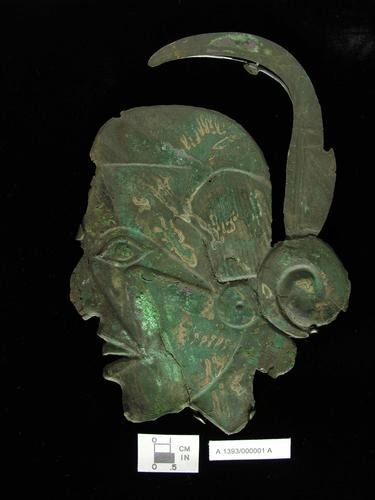
“Crouching Man” effigy pipe from Shiloh Indian Mounds, Tennessee:

More Spiro copper plate art, including a falcon dancer (or warrior) to the left. These are replicas for Spiro’s museum exhibit:
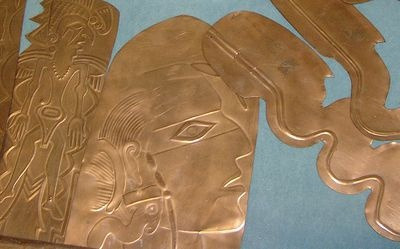
“Conquering Warrior” effigy pipe from Spiro. The wooden slat backshield he is wearing has similarities to the armor worn by Great Lakes tribes, which also protected the head and neck in this way:

Wood duck effigy bowl, diorite. Moundville, Alabama:
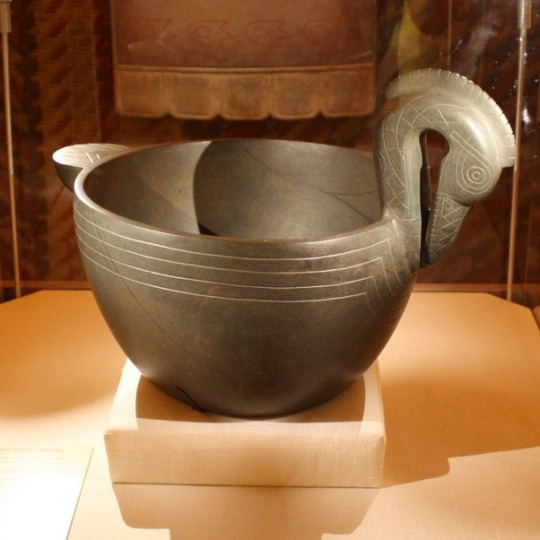
Shell gorget of two dancers from the McClung Museum of Natural History & Culture in Tennessee:
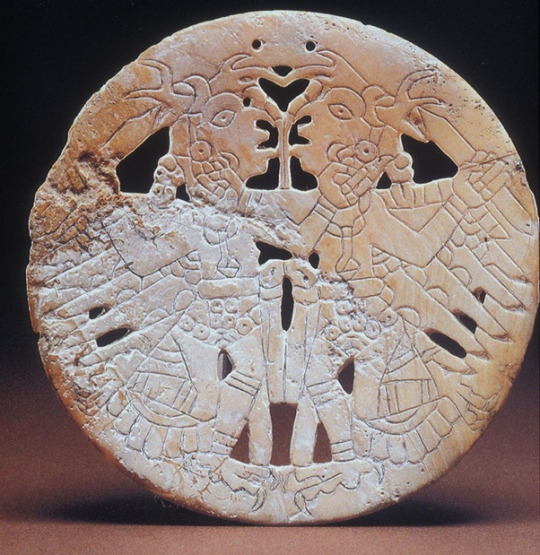
But one of the most profound examples of Mississippian culture, and what everybody wants to see when they visit the sites, are of course the mounds:
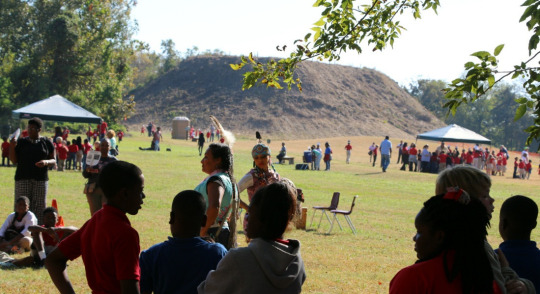
Winterville Mounds, Mississippi
These are no mere piles of dirt either, but alternating layers of various clays and particulates that each have their own physical properties and ostensibly spiritual meanings to ensure the greatest structural stability and proper religious status. Most of these clays were sourced from many miles out, even when a more convenient source was nearby. Most of these mounds were built to house a temple or chief, and the larger mounds served as residential-religious complexes for the elites. When the person living on the mound died, his house was burnt with any of his belongings and a new mound was constructed atop.
The most impressive of these Mississippian mounds, still standing today (in somewhat eroded form) is Monks Mound in the archaeological site of Cahokia:
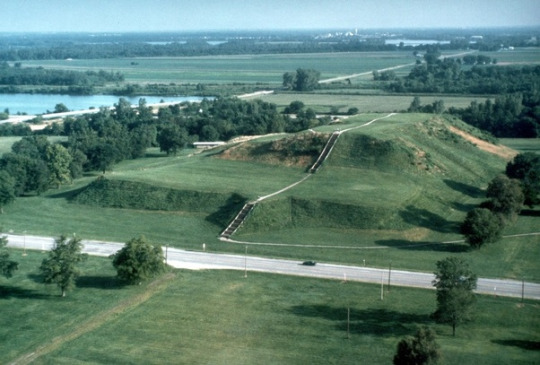
This terraced platform mound is 100 feet high, 775 feet wide, and 955 feet long; slightly larger at the base than the largest Egyptian pyramid.
The mound held multiple large buildings, including that of the paramount chief who overlooked a city we call Cahokia, the largest in pre-Columbian North America north of the Rio Grande, existing from A.D 1050 to 1350.
And there’s a highway right through it…
(A little outdated: there is evidence of clay caps on many Mississippian mounds, which means these mounds would have been a bright yellow or red instead of turf green)
The safe estimate for Cahokia’s population is around 20,000 people, but it has sometimes been given twice that. Either way, it’s reasonably impressive for the area and historical context. Our modern life has made us used to megacities spanning hundreds of thousands or millions of people, but to put 20,000 souls into perspective: This is close to the same size as London in 1200. Berlin was a quaint village of barely over a thousand at this time. Paris had very recently become a medieval metropolis at a hundred thousand people, but had floated at around 35,000 for about a millennium. The modern city of Ithaca, New York is around 30,000.
This city was America’s first melting pot, bringing in peoples from very distant regions who came for trade, religion and safety. The city was organized into districts according to class and sometimes function, including ‘industrial zones’ for production of things like beads, tools, pottery and copper art.
Outside the walled ceremonial district was a “Woodhenge”; a circular arrangement of poles that track the position of the sun like a giant solar calendar. Nearly all of the buildings are aligned to the four cardinal directions; the four directions to this day are important to many Native American tribes. Some pits within the city were dug as a source of clay and, if we can glean from historical accounts of native towns, were likely flooded and stocked with fish.
Cahokia faced many typical issues of a large early city: social order, sanitation, dietary deficiencies, and especially resource exhaustion (good timber had to be brought in from upriver). In finding a reason for Cahokia’s fall, it seems to have dealt with these okay enough. But some time after 1200 AD came an unusually wet era for the Mississippians, and all that extra rainfall drained into and rushed down the Mississippi, which would have drenched all of Cahokia but the tops of its mounds.
Interestingly, the Osage tribe, a Dhegihan-Siouan people that have one of the closest cultural similarities with the archaeological findings of Cahokia, have an origin story that draws many parallels (from Willard H. Rollings’ The Osage: An Ethnohistorical Study of Hegemony on the Prairie-Plains):
. . . in the beginning all of the Osage lived in a single village located along a river. One day the river flooded, and the Osage fled the rising waters. One group made it to the top of a hill, while others fled a nearby timbered ridge. A third group escaped to higher ground and sought shelter in a dense thicket, while a fourth group found refuge at the base of [a] hill just above the floodwaters. Some of the Osage, unable to escape, remained in the flooded village. After the floodwaters receded, the Non-hon-zhin-ga [council] insisted that the people remain in the groups they had formed during the flood. They claimed that Wa-kon-da [the Great Spirit/Mystery] wanted the people to live apart and to establish five villages . . .
After the flooding, Cahokia was still inhabited, but was a shadow of its former self. The people that lived there in the roughly 200 years until its final abandonment seem to have lived without a major elite class and used parts of Monks Mound as a garbage midden. Cahokia, once at the forefront of the Mississippian trade network, seems to have taken the long distance trade with it.
…but that’s not the end!
Mississippian culture was still alive and vibrant in the Lower Mississippi and Southeastern Woodlands (and the Middle Mississippi and Ohio River too, but the other places are more intense). However, times have changed. The lack of the Cahokian trade nexus has wrecked regional economies. Influence vacuums have formed and the world seems just a bit more dangerous. This is where history begins to rhyme a bit: there is an increase in fortification and town splitting, though not quite to the same degree. Towns are typically surrounded by a defensive wall and people move if the population gets too big, but complex hierarchies and earthworks are more active than ever. The political climate of the Southeast leads to the creation of vast open territories, with areas of dense wilderness serving to buffer the territories from large military campaigns (though light travel is still possible on trails). These territories, of course, had to be managed. And it’s during this era that we are finally able to know how the Mississippians governed themselves, at least in some parts, due to the accounts from Hernando de Soto’s entrada. In the Southeast among Muskogean (Creek) towns, the major town leader (potentially the paramount as well) was the mico/micco. Subordinate to the mico are the orata, which governed satellite towns. The iniha/heniha was an administrator served along the mico as a kind of magistrate and the yatika was the official translator. Each of these large territories was an italwa, and this word was also used to describe the largest towns ruled by micos, talofa being the smaller towns. The Caddo Mississippians in Texas and Oklahoma had the same structure, despite being on the other side of the Mississippian sphere.
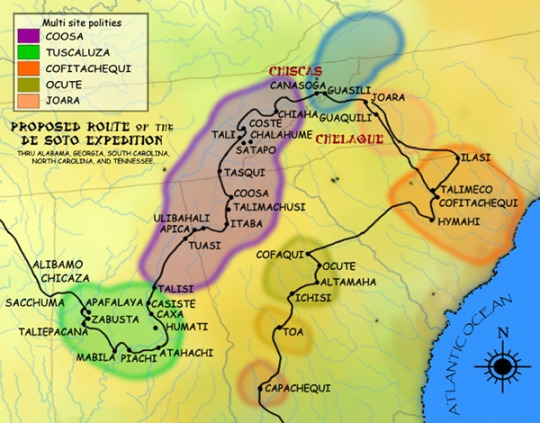
Hernando de Soto’s route through areas that are known Mississippian polities. There are more archaeological sites than shown here which could possibly represent other polities.
Starting from Florida, Hernando de Soto and his entrada entered Mississippian civilization, starting with the Appalachee (to the south, off-screen of the map) and into the Mississippi River proper. There they found large capitals with their mounds and walls, and many towns had other features such as moats and levies. Some of these moats seem to have doubled as fish traps, according to de Soto’s secretary Rodrigo Ranjel who described Pacaha’s (probably the Nodena site in Arkansas) moat as ”full of excellent fish of divers kinds”.
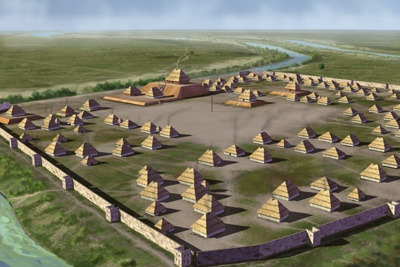
The Parkin site in eastern Arkansas, one of the places visited by Hernando de Soto
You will often hear that from here, Hernando de Soto’s very existence caused 90% of the natives to keel over from European diseases. However, there is actually no evidence of such mass deaths, even in towns that had Spanish artifacts. To make matters even more interesting, De Soto and some other Spaniards actually fell ill and died on this journey, at a point in the journey longer than the incubation period of known European diseases, with the natives unaffected!
But the entrada still had a devastating effect on the political atmosphere. In his search for gold and the desire to continue such a journey, de Soto raided and burned towns, forcibly occupied capitals and even kidnapped paramount chiefs — people who were supposedly of heavenly descent, reduced to being bound and caged for ransom. He used his influence to alter Mississippian political relationships to his benefit and this wrecked the status quo. The paramountcies of Coosa and Cofitachequi no longer had the same kind of respect, influence and control over their territories as they once had. Political cohesion was now much more tenuous.
The entrada would not be able to walk away from the Eastern Woodlands so easily, however. Shortly before he died, de Soto tried to use his claim as son of the Sun to force the chiefdom of Quigualtam, the largest and most powerful polity of the lower Mississippi, to give them safe passage down the Mississippi…and some tribute for the road, of course. Quigualtam wasn’t buying it. After a failed overland route near Texas, De Soto’s entrada (now led by Luis de Moscoso) built some ships and tried to sail down the Mississippi as quick as humanly possible.
Quigualtam, of course, caught up with them. The small Spanish river fleet was met by Quigualtam’s fleet of nearly a hundred canoes, many of which held up to 70 people. These large canoes had awnings in the back housing the commanders; the awnings, paddles, weapons, and the boats themselves were all one color, with a different color for each boat. They sang and drummed in unison to pace their paddling; most of the songs could be summed up as “You Spaniards sure are in for it now!”. There was, naturally, a very loud scream at the end of each song.
Once the boats got close, teams of divers jumped off the boats and into the water to board the Spanish’s pinnace boats. Other paddlers stood up and began firing volleys. They managed to kill, wound and capture some people, but made the decision not to engulf them entirely — Quigualtam’s plan was not to annihilate the Spaniards, but to harass, exhaust and terrify them enough that they understood who had the real power in the Mississippi, and would tell all of their countrymen back home. Which of course succeeded: every time the Spanish thought they out-sailed Quigualtam, they would hear the shouting again and the terror would start back up.
Quigualtam’s cultural descendants are the Natchez, whose society remained strongly Mississippian well into the historic period, interacting diplomatically with the United States.
Despite this successful expulsion of the Spaniards, it was only the beginning of the end for the Mississippian way of life as a whole. European ships were conducting slave raids all around the North American coast, as well as propping up some natives to become slave raiders themselves, which only expanded ever inward. This led to an increase in warfare, famine and mass uncertainty that undermined the political structure of the Eastern Woodlands, leading to the breakup of most Mississippian polities. It was only when the stresses from raids and starvation was at its peak that the first epidemics begin to sweep through; these events had lowered the immune system of natives. The Native American slave trade continued well into the age of the British colonies and early U.S., where Savannah, Georgia was an important port for the export of Native slaves.
De Soto’s accounts were buried in the libraries of New Spain, records of English colonial interactions with remaining Mississippian polities fell into obscurity, and the survivors of the Mississippian breakup had long since adopted new, somewhat more egalitarian lifestyles. Many of the old Mississippian towns and cities were revisited again as abandoned mounds. Rather than believe they were built by the ‘savage’ Indians they were killing and enslaving, people came up with numerous myths of other more prestigious people who came to America before them, only to be killed off by the current inhabitants. The Aztecs. Hindus. Babylonians. The Lost 13th Tribe of Israel. The Welsh. Anyone but the indigenous people. Thomas Jefferson was one of the first, after archaeological digs of his own, to suggest that the mounds were in fact built by Native Americans.
But the myth had always persisted. In fact, some pseudo-scientific circles to this day still deny the origins of the mounds in favor of their preferred civilization. And the lack of respect Americans have had for the mounds is exhibited by their constant destruction throughout American history. Massive temple platforms were excavated so their clay could be used for road fill or embankments. Some were simply in the way of progress: right across the river from Cahokia was the remains of a smaller city which was nearly completely torn down to make room for St. Louis. Only one deeply eroded Sugarloaf Mound remains. Many Mississippian sites are still on private land, their artifacts routinely dug up by plows while their discoverers don’t think much of it.
This has been simply another front of a campaign as old as the United States itself to destroy and mask the history and culture of Native Americans, so as to put European-American history and culture at the forefront. Today, we are more sensitive to the real history before the United States, and also have the power and resources to protect and educate. But the damage inflicted over the centuries has been done, and we are still reeling from its effects. It will take a while before Americans really truly become aware of their country’s pre-European past and realize it’s something to be celebrated, not quietly ignored. Until then, we should try to educate and raise awareness as much as we can.
As you can see, the Mississippi River did indeed give birth to some quite complex societies. You might also be wondering: why didn’t all this complexity happen earlier? Or reach the political strength of other river valley civilizations?
Well, first off I don’t think you can ever get a detailed answer to that. Many people like to fall on geography as the sole determiner of human society, but humans, as we all know, are complicated and do not like to follow the rules. Nevertheless, while the fertility of the Mississippi watershed can’t be overstated, the region is also perhaps a bit…too fertile. Most other river valley civilizations are in relatively dry areas, with a narrow stretch of fertile floodplain that forces most people to huddle together and submit to a central managing authority. In the Mississippi, you can have great farmland by the river, but you can also go deeper into the many, mazelike tributary rivers into the woods and have almost just as productive a crop. This is harder to keep under control, which narrows the focus of elites for the most part. However, ancient China had much the same layout: a large swath of fertile land under a complex watershed of not one but twogiant rivers. Horses, not available to the Mississippians, may have also played a part in such a difference. Or perhaps simply not enough time has passed since the Eastern Woodland’s adoption of agriculture in 1800 BC and the introduction of more efficient crops in 900 AD. If you’re asking me, a historical particularist, I believe that the fate of human societies can ultimately fall on the decisions made by their communities. The ideologies that led to the creation of sprawling, intensely bureaucratic states simply did not come to fruition in the same way they did in China or Mesopotamia. Maybe that was influenced by the factors I mentioned, or the values were simply different.
Yet a civilization it definitely was, with its own sophisticated cultures, politics, and artistic expression. Like many civilizations, it had its own peaks and dips, and with every dip rose a peak that was stronger than ever before. The collapse of the trade networks after 1400 was a dip the Mississippians had just begun to recover from. Considering the interruption of Mississippian history with the arrival of the Spanish, one has to wonder: what kind of peak might we have seen next?
Further Reading:
Mysteries of the Hopewell: Astronomers, Geometers, and Magicians of the Eastern Woodlands by William F. Romain
Ancient Cahokia and the Mississippians by Timothy R. Pauketat
Medieval Mississippians: The Cahokian World by Timothy R. Pauketat and Susan M. Alt
Mapping the Mississippian Shatter Zone: The Colonial Indian Slave Trade and Regional Instability in the American South by Robbie Ethridge and Sheri M. Shuck-Hall - goes into the political instability caused by European activity that led to the collapse of many Mississippian polities
Epidemics and Enslavement: Biological Catastrophe in the Native Southeast, 1492-1715 by Paul Kelton - also discusses the shatter zone, but builds upon it by touching on the biological aspect. Particularly, it addresses the myth of the spread of European disease in the EW: rather than the wildfire-like instantaneous transmission many imagine, the worst of the epidemics only came about when the immune systems of the natives were weakened through stresses.
The Forgotten Centuries: Indians and Europeans in the American South, 1521-1704 by Carmen Tesser and Charles Hudson - very aptly named; in-depth exposition of the often overlooked protohistoric period, inbetween the jurisdictions of archaeologists and historians.
Amazon.com: Knights of Spain, Warriors of the Sun: Hernando de Soto and the South's Ancient Chiefdoms by Charles Hudson and Robbie Ethridge - Contains actual primary sources of de Soto’s journey, augmented and illuminated by the interpretations of modern historical and archaeological data.
1 note
·
View note
Text
Medieval cosmetics: The history of looking good
So, I recently saw a post on my dash with someone lamenting the fact that in the medieval era, they would have been considered ugly as there was no makeup, and someone else offering a well-meant attempt to reassure them: that since they’d have no pox scars, rotten teeth, filthy hair, etc, all medieval men would think they were amazingly hot. While I appreciate the sentiment, there’s.... more than a little mythology on both sides of this idea, and frankly, our medieval foremothers would be surprised and insulted to hear that they were apparently the stereotyped bunch of unwashed, snaggle-toothed crones who put no care or effort into their appearance, and had no tools with which to do so.
(Or: Yep. Hilary Has More Things To Say. You probably know where this is going.)
I answered an ask a couple weeks ago that was mostly about medieval gynecological care and the accuracy of the “mother dying in childbirth” stereotype, but which also touched on some of the somehow still-widely-believed myths about medieval personal care and cleanliness. Let’s start with bathing. Medieval people bathed, full stop. Not as frequently as we do, and not in the same ways, but the “people never washed in Ye Olde Dark Ages” chestnut needs to be decidedly consigned to the historical dustbin where it belongs. “A Short History of Bathing Before 1601″ is a good place to start, as it follows the development of bathing culture from ancient Rome (where bathhouses were known for their use as gathering places and influential centers of political debate) through to the modern era. Yes, common people as well as the nobility washed fairly frequently. Bathing was a favored social and leisure activity and a central part of hospitality for guests. Hey, look at all these images in medieval manuscripts of people bathing. Or De balneis Puteolanis, which is basically a thirteenth-century travel guide to the best baths in Italy. Or these medieval Spanish civic codes about when men, women, and Jews were allowed to use the public bath house. There was also, as referenced in the above ask, the practice of washing faces, hands, etc daily, and sometimes more than once. Feasts involved elaborate protocol about who was allowed to perform certain tasks, including bringing in the bowls of scented water to wash between courses. They associated filth with disease (logically). Anyway. Let’s move on.
Combs are some of the oldest (and most common) objects found in medieval graves -- i.e. they were a standard part of the “grave goods” for the deceased, and were highly valued possessions. Look, it’s a young woman combing her hair (that article also discusses the history of medieval makeup for men, which was totally a thing and likewise also suspected of being “unmanly.”) The Luttrell Psalter, now in the British Library, includes among its many illuminations one of a young woman having her hair elaborately combed and styled by an attendant. There were extensive discourses on what constituted an ideally attractive medieval woman, and the study of aesthetics and the nature of beauty is one of the oldest and most central philosophical enquiries in the world (as were beauty standards in antiquity). Having a pale complexion was a sign of wealth (you didn’t have to work outdoors in the sun) and women used all kinds of pastes and powders to achieve that effect. Remember the Trotula, the medieval gynecological textbook we talked about in the childbirth ask? Well, it is actually three texts, and the entire third text, De ornatu mulierum (On Women’s Cosmetics) is dedicated to makeup and cosmetics. What weird and gross sort of things do they advocate, cry editors of “7 Horrifying Medieval Beauty Tips You Won’t Believe!”-style articles? Well...
First come general depilatories for overall care of the skin. Then there are recipes for care of the hair: for making it long and dark, thick and lovely, or soft and fine. For care of the face, there are recipes for removing unwanted hair, whitening the skin, removing blemishes or abscesses, and exfoliating the skin, plus general facial creams. For the lips, there is a special unguent of honey to soften them, plus colorants to dye the lips and gums. For the care of teeth and prevention of bad breath, there are five different recipes. The final chapter is on hygiene of the genitalia. [...] A prescription said to be used by Muslim women then follows.[...] The author gives detailed instructions on how to apply the water just prior to intercourse, together with a powder that the woman is supposed to rub on her chest, breasts, and genitalia. She is also to wash her partner’s genitals with a cloth sprinkled with the same sweet-smelling powder.
Wait so... hair care, skin and facial creams, toothpaste, lipstick, and sexual hygiene?? With the latter based on that used by Muslim women??? Zounds! How strange and unthinkable!
L’ornement des Dames, an Anglo-Norman text of the thirteenth century, offers more tips and tricks, and explicitly references the authority of both the Trotula and Muslim women: “I shall not forget either what I learnt at Messina from a Saracen woman. She was a doctor for the people of her faith [...] according to what I heard from Trotula of Salerno, a woman who does not trust her is a fool.” So yes. The beauty regimes of Muslim women were transmitted to and shared by Christian women, especially in diverse places like medieval Sicily, and this was valuable and trusted advice. Gee. It’s almost like women have always a) cared about their appearance, and b) united to flip one giant middle finger at the patriarchy. (You can also read more about skincare and cosmetics.) Speaking of female health authorities, you have definitely (or you should have) heard of Hildegard von Bingen, a twelfth-century abbess and towering genius who was the trusted advisor of kings and popes and wrote treatises on everything from music to medicine to natural science (she is regarded as the founder of the discipline in Germany). This included the vast Physica, a handbook on health and medicine, and Causae et curae, another medical textbook.
Did the church grumble and gripe about women putting on excessive adornments and being too fixated by makeup and the dangers of vanity and etc etc? You bet they did. Did women ignore the hell out of this and wear makeup and fancy clothes anyway? You bet they damn well did. Also, medieval society was fuckin’ obsessed with fashion (especially in the fourteenth century.) The sumptuary laws, which appeared for the first time in the late thirteenth and early fourteenth centuries, regulated which classes of society were allowed to wear what (so that fancy furs and silks and jewels were reserved for the nobility, and less expensive cloth and trimming were the province of the lower classes -- the idea was that you could know someone’s station in life just by looking at them). These were insanely detailed, and went down to regulating the height of someone’s high heels. So yes, theoretically, the stiletto police could stop you in fourteenth-century England, whip out a measuring tape, and see if you were literally too big for your britches.
(”But, but,” you stammer. “Surely they had rotten teeth?” Well, this is probably a bad time to note that in addition to the five toothpaste remedies mentioned in the Trotula, there are even more. Jewish and Muslim natural philosophers and herbalists had all kinds of recommendations -- see Practical Materia Medica of the Medieval Eastern Mediterranean. Also, since there was no processed sugar in their diet, their dentistry was far better than, say, the Elizabethans, and white and regular teeth were highly prized. There would be wear and tear from grist, but since fine-milled white bread was a status symbol, the wealthy could afford to have bread that did not contain it, and thus good teeth.)
Of course, everyone wasn’t just getting dressed up with, so to speak, nowhere to go. What about sex? It never happened unless it was marital rape, right? (/side-eyes a certain unnamed quasi-medieval television show). Oh no. Medieval people loved the shit out of sex. Pastourelles were an immensely popular poetic genre which almost always included the protagonist having a romp with a pretty shepherdess, and anyone who’s read any Chaucer knows how bawdy it can get. Even Chaucer, however, is put to shame by the fabliaux, which are a vast collection of Old French poems that have titles so ribald that I could not say them aloud to an undergraduate class. (”The Ring That Controlled Erections” and “The Peekaboo Priest” are about the tamest that I can think of, but I gotta say I’m fond of “Long Butthole Berengier” and the one called simply “The Fucker,” because literally people are people everywhere and always. And yes, you perverted person, you can read the lot of them here.) This was incredibly explicit and bawdy popular literature that was pretty much exactly medieval porn (and like usual porn, did not exactly serve as any kind of precursor of feminist media or positive female representation, but Misogyny, Take a Shot.)
So yes. Once more (surprise!) the history of cosmetics goes back at least six thousand years, and is one of the oldest aspects of documented social history in the world. It existed broadly and accessibly in the medieval world, where women had other women writing books on it for them, and was just as much as a concern as it is now. People have always liked to look good, smell good, accessorize, dress fashionably, try weird beauty trends, and so forth. So if by some accident you do stumble into a time machine and end up in medieval Europe, you’ll have plenty of choices. Our medieval foremothers, and the men who loved them and thought they were beautiful, thank you for your time.
#history#medieval history#history of cosmetics#history of makeup#women in history#history of medicine
6K notes
·
View notes
Text
Gervonta Davis Seeks Title In A Third Division Against Unbeaten Mario Barrios
(adsbygoogle = window.adsbygoogle || []).push({});
Follow @Frontproofmedia!function(d,s,id){var js,fjs=d.getElementsByTagName(s)[0],p=/^http:/.test(d.location)?'http':'https';if(!d.getElementById(id))(document, 'script', 'twitter-wjs');
Published: May 20, 2021
Top Contender Erickson Lubin and Former Unified Champion Jeison Rosario Battle in WBC Super Welterweight Title Eliminator in Co-Main Event Former Unified Champion Julian Williams Takes On Rugged Contender Brian Mendoza and Hard-Hitting Olympian Batyr Akhmedov Duels Former World Champion Argenis Mendez In Pay-Per-View Action Beginning at 9 p.m. ET/6 p.m. PT
ATLANTA – Four-time world champion Gervonta “Tank” Davis will take on a career-defining challenge as he sets his sights on capturing a title in a third weight class when he faces undefeated WBA Super Lightweight Champion Mario “El Azteca” Barrios in a SHOWTIME PPV main event Saturday, June 26 at the award-winning State Farm Arena in Atlanta in an event presented by Premier Boxing Champions. The pay-per-view undercard will feature a battle of two top 154-pound contenders as Erickson “Hammer” Lubin faces former unified champion Jeison Rosario in a WBC Super Welterweight Title Eliminator in the co-main event. Former unified super welterweight champion Julian “J-Rock” Williams returns to the ring for the first time in 18 months to take on Brian Mendoza in a 10-round showdown and hard-hitting Olympian Batyr Akhmedov steps in against former world champion Argenis Mendez in a 12-round WBA Super Lightweight Title Eliminator to kick off the pay-per-view telecast at 9 p.m. ET/6 p.m. PT. Tickets for the live event at State Farm Arena, which is promoted by Mayweather Promotions, GTD Promotions and TGB Promotions, go on sale Friday at 10 a.m. ET, and can be purchased at ticketmaster.com. “I am ready for anything Akhmedov brings and then a world title fight after,” said Mendez. “I believe that I beat Hitchins in my last fight, even though I was coming off a long layoff. I’m in great shape right now. Akhmedov is a hard puncher, but the fans are going to see me shine against him. There is a lot left in my tank and that will be obvious to everyone on June 26.” A former super featherweight champion, Mendez (25-6-3, 12 KOs) has a reputation for providing stiff challenges to the sport’s best and has proven to be a durable contender at 140-pounds, including his most recent outing that saw him drop a split-decision to Richardson Hitchins last December. In 2019, Mendez fought to back-to-back draws against super lightweight contenders Anthony Peterson and Juan Heraldez. Born in San Juan de La Maguana, Dominican Republic, Mendez now fights out of Yonkers, N.Y. and owns victories over Eddie Ramirez, Ivan Redkach and former titlist Miguel Vazquez. He has also gone toe-to-toe with former champions Rances Barthelemy and Robert Easter Jr. “I can’t wait to get back in the ring for a big fight on June 26,” said Akhmedov. “I’ve been training hard to get another shot at the title. I know that if I make a big statement and defeat a former world champion in Mendez, I expect my next fight will be for the title. I’m always in exciting fights that fans love, and this matchup is going to be no different.” Born in Uzbekistan and now fighting out of Los Angeles, Akhmedov (8-1, 7 KOs) represented Turkey at the 2016 Olympic games. The 30-year-old turned pro in 2017 and won his first seven pro fights, with six coming by knockout. His lone blemish came in an action-packed title fight against Mario Barrios in September 2019, where he was able to survive two knockdowns to make it a close fight, before eventually losing by decision. Most recently, Akhmedov blasted out Ray Perez in the first round of their September 2020 clash. “This fight against Julian Williams is just the fight I’ve been waiting for,” said Mendoza. “I’m planning to take full advantage of the opportunity. Julian Williams is a great fighter, but after June 26, the whole world is going to know that I belong at this level.” Mendoza (19-1, 13 KOs) earned a career best-victory in his last outing, beating veteran contender Thomas LaManna by unanimous decision in August 2020. The 27-year-old has fought professionally since 2014, with his only defeat coming by a narrow split-decision in November 2019 against Larry Gomez. Mendoza was born in Albuquerque, New Mexico, where he won two New Mexico Golden Gloves Championships as an amateur, and currently fights out of Las Vegas. “This has been the longest layoff of my career, so I’m excited to get back in the ring,” said Williams. “Mendoza is a decent fighter. I’ve even been in the gym with him and he’s a good guy. But on June 26, it’s going to be all business. I just need to come out on top. He doesn’t have anything that I haven’t seen before. I know he’ll be ready because this is like the Super Bowl for him. So I know he’ll be ready, but I’ll be ready too. If I’m able to get the win, then it’s on to bigger and better opportunities. But I’m definitely not looking past Brian because I know how seriously he’s taking this fight.” Philadelphia’s Williams (27-2-1, 16 KOs) became a unified world champion at 154-pounds in May 2019 when he upset Jarrett Hurd in one of the year’s best fights, winning a close-quarters brawl by unanimous decision. The 31-year-old dropped the titles in his first defense, losing to Jeison Rosario in January 2020. Williams had been riding a five-fight winning streak going into the Rosario matchup, in which he added victories over former champion Ishe Smith and hard-hitting contender Nathaniel Gallimore to his ledger. “I make no excuses for losing the fight to Charlo, but that was then, and this is now,” said Rosario. “I have turned to a new page in my career with my new trainer Herman Caicedo. I will not lose again, especially in this fight against Lubin. He’s a great contender, and I respect his abilities, but I will knock him out on June 26.” Rosario (20-2-1, 14 KOs) will look to climb back into world title contention after losing his 154-pound belts to Jermell Charlo in their September 2020 clash. The 26-year-old captured the WBA and IBF belts by stopping Julian Williams in one of 2020’s biggest upsets. Born in the Dominican Republic and now fighting out of Miami, Rosario rode an eight-fight unbeaten streak into the showdown with Williams, including victories over 154-pound contenders Jamontay Clark, Justin DeLoach, Jorge Cota and Marcos Hernandez. Coming into the Charlo matchup, Rosario had established his power by earning a stoppage victory or scoring a knockdown in seven of his previous nine contests. “I’m so ready for this fight and we’ve been working hard in preparation for Rosario,” said Lubin. “This fight is another step closer to getting that world title shot. Coach Cunningham and I have a great game plan in place. We know this is going to be a tough fight and the fans are going to see a much-improved version of myself. I’ve taken my training to the next level during this training camp. Rosario is a former world champion who I know is going to bring his best, which is going to make for a great night of boxing. This card is stacked, but I’m going to steal the show with an incredible performance. I will not be denied, I’m coming out on top. It's Hammer Time!” The 25-year-old Lubin (23-1, 16 KOs) has put together an impressive five-bout winning streak since a loss to unified 154-pound champion Jermell Charlo in 2017. In his most recent outing, he defeated U.S. Olympian Terrell Gausha by unanimous decision in September of last year. Prior to the victory over Gausha, he became the first person to stop former champion Ishe Smith, in addition to a dominating victory over Nathaniel Gallimore in October 2019. A native of Orlando, Fla., Lubin is trained by acclaimed coach Kevin Cunningham as he continues his quest toward another title opportunity. After a stellar amateur career, Lubin turned pro at 18 years old in 2013, eventually being named “Prospect Of The Year” by ESPN and Ring Magazine in 2016. “Fighting on SHOWTIME PPV is a dream come true and an opportunity that I’m going to take full advantage of,” said Barrios. “Gervonta Davis is a pound-for-pound champion and it’s going to be an honor sharing the ring with him. This fight is my shining moment and the pinnacle of the boxing world, on the biggest stage possible. Boxing fans around the globe will be watching this fight and I’m coming to shock the world. To all my Mexican fans, I'm going to bring this historic victory home for La Raza.” Standing nearly six-feet tall, Barrios debuted as a pro at super bantamweight in 2013 and had success moving up the rankings in the super featherweight division. His first 140-pound bout came in 2017 and saw him increase his power from his previous performances. At super lightweight, Barrios has scored knockouts in every fight except the title-winning performance against Akhmedov, where his power was still on display with a pair of knockdowns. Barrios (26-0, 17 KOs) captured his 140-pound championship in September 2019, scoring two knockdowns and fighting through a cut to win a unanimous decision over previously unbeaten Batyr Akhmedov. The San Antonio-native trains in Oakland, Calif., under the guidance of renowned coach Virgil Hunter. In his most recent outing, Barrios knocked out Ryan Karl in the sixth-round of their clash on the pay-per-view undercard of Davis vs. Santa Cruz. “I’m excited to make history on June 26 in Atlanta and become a three-division world champion,” said Davis. “Atlanta welcomed me with open arms for my fight against Gamboa and I couldn’t wait to come back and headline a spectacular SHOWTIME PPV card. Mario Barrios is an undefeated champion, but he hasn’t ever faced anyone like me before. Moving up to 140-pounds is a big challenge but I’ve been working hard in camp and I’ll be ready. Thank you to my whole team for making this historic boxing event possible. Make sure you get your tickets early because this fight is definitely selling out! Keep supporting me and I’ll fight for you!” in January 2017. At the time, he became the youngest world champion in boxing at age 22. The Baltimore-native also owns knockout performances in world title fights over Jesus Cuellar in 2018 and Yuriorkis Gamboa in 2019. The 2019 triumph over Gamboa came at a sold out State Farm Arena, during a year that also saw him fill venues in his hometown of Baltimore and Southern California.®Davis first burst onto the scene with an explosive knockout victory over Jose Pedraza to win the IBF Junior Lightweight World Title in a star-making performance on SHOWTIME Davis (24-0, 23 KOs) delivered a highlight-reel knockout in his last fight, producing another sensational and memorable performance that has made him a popular draw throughout the country. Davis stopped four-division champion Leo Santa Cruz with one powerful uppercut in that October 2020 fight and put Santa Cruz down and out for the first time in his illustrious career. Promoted by Mayweather Promotions, Davis will make his second headline appearance on pay-per-view as he has asserted himself as a must-see headline attraction in his first pay-per-view “Gervonta Davis is looking to become a three-division world champion, and has a big undertaking in front of him in challenging Barrios for his WBA title at 140-pounds,” said Leonard Ellerbe, CEO of Mayweather Promotions. “Barrios is a warrior, and this is going to be Davis’ toughest fight to date. Atlanta, be ready for a show on June 26!” One of boxing’s biggest stars at just 26-years-old, Davis moves up to 140-pounds for the first time in his career as he aims to add super lightweight champion to his stellar resume. Davis has already captured titles at 130 and 135-pounds. With a victory, Davis will hold world championships in three different divisions simultaneously, a feat only accomplished by a few fighters in history, including Henry Armstrong and Canelo Alvarez. Standing in his way is the undefeated 25-year-old Barrios, who owns a 9-0 record with eight knockouts during his 140-pound reign while holding a six-inch height advantage over Davis.
0 notes
Text
I went to the Museum of the Bible
Okay, buckle in, because this is gonna be kind of a lengthy post. My mom got free tickets to the highly controversial new Museum of the Bible in DC and I, with heavy misgivings, decided to come along and see what was up. I have to say, I thought it was a lot better than I expected, though I am still suspicious and cynical of several aspects of the place. So here is my detailed review! Here's what you need to know about the museum first: 1. It was founded and funded by Steve Green, the President of Hobby Lobby, aka the company that went to the Supreme Court because they didn't want to cover employees' birth control, saying it went against their religious beliefs. 2. He was also fined $3 million for smuggling artifacts from Iraq (which did not appear in the museum's collection). 3. The museum is technically non-sectarian (though with a Protestant bias), and does not address hot-button issues like evolution/creationism, abortion, LGBTQ+ rights, or how the Bible "should" be interpreted. Its galleries include tellings of the stories from the Bible, the history of the compilation and transmission/translation of the Bible, and the impact of the Bible on history and culture. It always hints at a Christian interpretation but does not outright evangelize. Some people may find this claimed non-political and nonsectarian interpretation more insidious than an outright Christian oriented museum. 4. The museum is free, but with a suggested donation. I would personally not suggest donating anything if you're interested in checking it out so as not to put money in the Hobby Lobby Guy's pockets, but that's just me. Now, I have to address my own personal biases. I am a Protestant Christian (United Methodist, to be specific), but I'm also strongly opposed to what constitutes contemporary "American Christian culture." I'm a believer not only in God but in human rights, evidence-based science/evolution, separation of church and state, charity, equality, and empathy. To me, these values are compatible with studying Jesus' teachings, and I'm deeply critical of people who use Christianity to justify selfish and narrowminded decisions. I also am an elementary-age Sunday school teacher who likes to emphasize the importance of Biblical literacy in self-professed Christians, which this museum champions (you'd be amazed how many Christians aren't actually familiar with the Bible), and in studying not only the stories, but the themes and lessons behind them (which this museum does not do. It allows guests the freedom to interpret the material according to their own beliefs- again, some might like this and some might dislike it). This museum is huge. We were there for about five hours and still didn't see everything. It was also absolutely PACKED with guests. The line to get in snaked down the block, and there were some long lines to get into the "hottest ticket" exhibits. We started off our day in the most popular, multi-media exhibit, The Hebrew Bible, which is a mix of videos and walk-through visuals with exciting lighting, animation, and voiceover, telling the narrative of major Old Testament stories. This exhibit is a pure storytelling "experience" and does not display any artifacts or purport to be a factual account, which I actually love because it is not claiming that all of these accounts are literally true or trying to show historical evidence. It's a little cheesy but less cheesy than you might expect- it feels like an elegant Disney World attraction but with a more artistic and slightly more abstract style. I especially liked the burning bush (the voice of God was represented as multiple voices in unison, at least one of them female), the white room full of rainbow light after the ark, the Red Sea made of string and projected waves, or the watercolor style of art of the Judges/Samuel movie. This experience is as non-controversial as possible, though the one issue is that it portrays the entire Old Testament as a consistent story about how God's people moved closer to and farther from God throughout history, fluctuating in loyalty, which I've heard is contrary to how the Tanakh is generally interpreted. This also implies that the New Testament completes "the story," which shows a Christian bias. The next exhibit was a recreation of the village of Nazareth, which WAS cheesy and Disneyesque, but fun. It felt like the museum at Jamestown Settlement, where you can walk in the little houses and see how people lived in another time. There were living interpreters there, and I liked that the people who played the villagers were racially diverse. There was a mikvah, an olive press, a temple, and typical Jewish homes. Less diverse was the short movie about John the Baptist and King Herod, who were both played by white actors- in fact, Herod was John Rhys-Davies (aka Gimli) in all his bellowing rolled-r scenery-chewing glory. He seemed to be having a grand old time. The New Testament movie was poignant but a slightly more cartoonish style of animation than the Old Testament films. Its art style reminded me of the illustrations on Pottermore. There are a lot of contradictory versions of stories in the Gospels, which was not acknowledged in this movie, but they kind of found a way around this by having the movie told from the perspectives of different people who encountered Jesus in first person (John, Saul/Paul, Mary Magdalene, Thomas, a centurion at the crucifixion, etc), showing them as varying accounts rather than one narrative. I know about the differences between the Gospels, but not everyone does, and this could be interpreted as an oversimplification. One thing I loved about this movie was that they never showed Jesus' face. They allow the audience to imagine him as they see fit. My family got lunch after this. There's a big restaurant called Manna on the top floor that serves middle-Eastern inspired foods and it was quite good. (There are vegetarian, vegan, and kosher options.) I had a platter with falafel, salad, and pickled vegetables, as well as some mango juice. This place gets CROWDED and there are long lines, but you can't re-enter the museum once you've exited unless you get back in the big queue around the block, so you can really only eat here or at the coffee shop downstairs. There's also a biblical garden and observation deck up there. Next, we went to the floor that talks about the history of the Bible, and this is where things get complex. I am less knowledgeable about this stuff than the actual text of the Bible itself, so I can't tell you what was of questionable accuracy here and what was legit, but this floor was definitely poised as being more serious and academic, while the one above it was more about narrative and entertainment-- so obviously, I was side-eying it more. This exhibit is definitely slanted toward the concept that the Bible has been transmitted and translated throughout time with remarkable accuracy, but also explores the differences, inaccuracies, and variations between different Bibles. It starts with a collection of ancient tablets and documents. I have read that some of these have questionable provenance and authenticity, especially fragments of the Dead Sea scrolls. Some of the signage alludes to these questions, some does not. Many items are on loan from other institutions, while others are replicas and facsimiles of items in museums like The British Museum (always labeled as such). The articles of the museum I've read are very severe about questions of authenticity/provenance, partially because of the Hobby Lobby scandal, but also because this is such a new museum. Museum practices have changed over time, and many of the artifacts at the British Museum and the Met are unethically acquired, too. Bear that in mind when visiting any museum (I could rant to you about the Parthenon marbles!) Still, a new and expensive museum like this one should be more careful. The most interesting ancient items in this exhibit were accounts from non-Jewish ancient cultures that told a different version of events than the Bible-- a king claiming to have killed a Hebrew King and thanking his own gods for the victory, while the Bible says that God punished that Hebrew King for not being devoted to him. It was cool to see two sides of the same story. But what I REALLY loved here was the collection of Bibles from the Middle Ages and Renaissance, because I love old books. Like, I took a class at the Folger Shakespeare Library about this stuff. There was a Gutenberg Bible, some absolutely gorgeous illuminated manuscripts (including one belonging to Henry V's great-grandmother and in immaculate condition), Tyndale Bibles, one of the very first edition of the full Bible in English... It was sobering to see that Henry VIII commissioned churches to display Bibles in English two years after Tyndale was executed abroad for translating the Bible into English. My favorite thing in the entire museum was a "Wicked Bible"- a reprint of the King James Bible that accidentally left out a crucial word and said, "Thou shalt commit adultery." Needless to say, most of them were destroyed, and the printers got in trouble, but this one survived. I also liked the small exhibits on which books were included in which versions of the Bible and which were left out/ considered apocrypha. The "Drive Thru History." introductory movie here is incredibly annoying and trying too hard to be cool, by the way, so feel free to skip that one if you go. It does a disservice to a serious collection of books. I also popped into the second floor exhibits before I left, but I didn't stick around for long. This has exhibits on the Bible's impact on US history and on culture in the world. The culture one honestly was so overwhelming and sprawling that it hurt my brain (especially since I had already been in the museum for 4.5 hours), but I did get a kick out of seeing Elvis Presley's Bible. This might be the most propaganda-Y part of the museum, but I didn't take much time to find out. There's also a video booth where people can share their own feelings or experiences about the Bible. The American history section was interesting and surprisingly daring, though. It talked about how the Bible was used to back up positions on different sides of issues through history- pro- and anti- slavery, women's rights, whether to be independent from England. It showed that the Bible has been used for good and bad throughout history and has some cool documents on display- a first edition copy of Uncle Tom's Cabin, Elizabeth Cady Stanton's "Women's Bible," the handwritten manuscript of the Battle Hymn of the Republic. The displays let the public vote on tricky questions like whether they agree with Thomas Jefferson's decision to cut up the Bible and keep the parts that he felt applied as advice to daily life. (73% say no.) Also, in a section about politicians making reference to their personal faiths, there is a clip of Barack Obama singing "Amazing Grace." Nice to see that this museum explicitly denies the "Obama is a secret Muslim" conspiracy. There were more exhibits that I didn't get to see, including some traveling exhibits on loan from the Vatican, an Israeli museum, and a Bavarian museum. They also have a full-stage production of the Broadway musical "Amazing Grace." I will say, I gave a hard side-eye to the large gift shop, through which visitors exit, with the "Museum of the Bible" logo branded on everything from mugs to t-shirts to sunglasses. I would have preferred a tasteful bookshop with maybe a few knick-knacks like cross necklaces and Noah's Ark toys, but I guess I'm an old party-pooper. Overall, I actually had a lot of fun at this museum and got to see some very cool and rare books, but I also was naturally more critical toward this museum's decisions than I normally would be when visiting a tourist attraction. I was happy to see a crowd diverse in age and ethnicity who were discussing the exhibits rather than just zooming through (I did see one guy in a MAGA hat, though- frankly, I thought there might be more). The employees were all really nice and helpful even though the place was outrageously crowded. Would I recommend visiting this museum? Maybe! I think I would recommend it to Christian people who are already knowledgeable about the Bible and willing to think critically about what they read and see. I think it would be a good place to bring kids (mid-elementary and up) and talk seriously about some of these topics and controversies. The kids in my Sunday school class seem to have a hard time remembering sequence of events in the Bible, thinking Moses was the same time as Jesus, calling King David a 'Christian,' etc. This might clarify some stuff. I saw a lot of little kids there, and they were having fun, but I feel like I wouldn't take kids that young there because they wouldn't be able to understand the more complex topics. I don't want to just give them candy-coated pretty stories! I probably would not recommend this museum to people who come from very different faith traditions or none at all, whatever this museum's attempts at secularity. I will say, I'm unsure what the Museum of the Bible's agenda is, because it certainly doesn't seem built to convert anybody. The more cynical part of the says it's built to spread the message that the Bible is so important to history and culture that it should be taught in schools. The less cynical part says that it's built to encourage Christians to explore and become more knowledgeable about their faiths, because we're from a time when the majority of Americans identify as Christian, but very few have read the Bible or can answer basic questions about it. I think that's dangerous, because lots of people seem to adhere more to "Christian" culture than Christian scripture, and that leads to a mindset completely divorced from what I see as Jesus' teachings. I don't personally have a problem with its location near the Mall and the Capitol, because if anything else, I see it as a sign of the separation of Church and State. The museums on and around the mall explore different cultures and fields of study, so does one-- but I hope people who visit DC for this museum also visit some of the Smithsonian museums. Learn about Natural History, African-American history, Native-American History, not just the museum about your own religious faith. Please feel free to ask me any questions about the museum!
37 notes
·
View notes
Text
So there is this cool gnome article! Thanks for writing this Max!
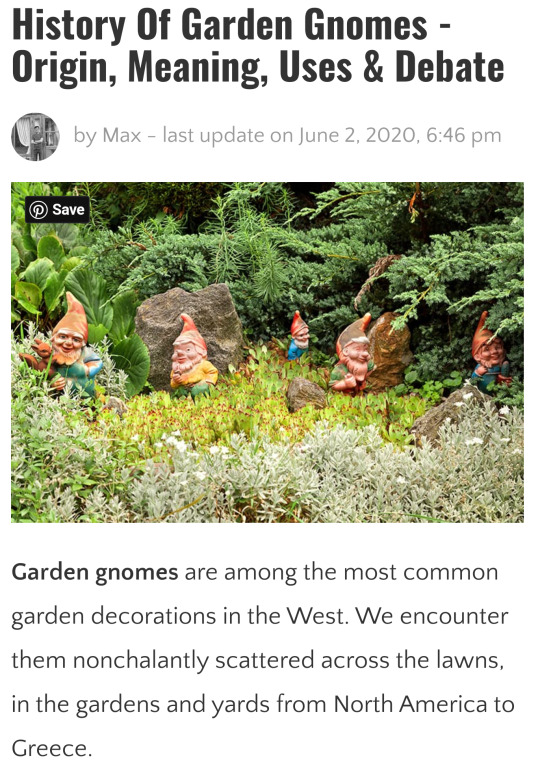

Garden Gnomes Meaning
The etymology of the word "gnome" is not completely clear. Paracelsus, named elemental earth beings pigmaei or gnomi to, possibly from the Greek word "genomos" meaning "earth-dweller."
It is less likely that "gnomus" was derived from the similar-sounding Greek word gnosis, meaning "knowledge."
Petite Gnome In Ancient Rome
The earliest appearance of garden gnome-like statues was in ancient Rome. Their garden forerunners were statues that represented the Roman gods.
The most common among them was the god Priapus, a minor fertility deity who originally came from Greek mythology. He was a protector of livestock, planting, and gardening, which was symbolized by the depiction of his… Well, permanent erection.
The primary function of these statues was to protect the gardens from evil spirits, as well as to ensure a successful harvest.
Early Modern Period-From Gobbi to Lampy

Swiss Alchemist Paracelsus Was The First One To Described Gnomes As Creatures With Magical Powers
In the Renaissance era, the grotesque potential of those statues was expanded following the general spirit of the age.
Swiss alchemist Paracelsus was the first one who described them as creatures with magical power. According to him, gnomes were one of the four elementals or nature spirits (invisible beings that existed among humans), belonging to the earth. They would come out at night to help plants grow. During this period, gnomes were pleonastically called "Grotesques" and thus were made to be ugly petite hunchbacks, painted in bright colors and usually named by the Italian word "Gobbi."
Garden gnomes became widely popular as home ornaments by the beginning of the 18th century, but mostly for wealthy families only.
The popularity of gnomes persisted thanks to the folklore, myths, and stories from around the world, such as German fairy tales, where gnomes and dwarfs were present largely as little creatures with mythical power helping humans in farming. They were a good example of how folklore and mythology influenced the history of everyday life.
The First Garden Gnome
It is believed that the very first contemporary-looking garden gnome (with the iconic red hat), was made in Germany by sculptor Phillip Griebel. Soon, the fashion had spread across Europe, from England to Poland, and Griebel concentrated his entire manufacturing around producing garden gnomes.
Consequently, the manufacture of gnomes became very common in Germany, with different businesses emerging across the country, although Griebel remained famous among them, and still exists as a family business in Germany.
In the 19th century, Sir Charles Isham brought several of Griebel’s gnomes to England, introducing them to the new market. He is credited with beginning the tradition of garden gnomes in the United Kingdom, where they were nicknamed "Lampy." One replica is still preserved and displayed in Lamport Hall, the Isham family residence in Northamptonshire.
The 20th Century- Intermittent Rise And Fall Of Gnome
The beginning of the modern era in Europe brought troubling and uncertain times, which culminated with World War I and World War II. Their consequences changed the course of modern history, as well as leisure time habits. Unsurprisingly, the popularity of garden gnomes was in decline during this period.

The Snow White And Seven Dwarfs Movie lay in restoring the glory of Garden Gnomes in the 21st Century
However, thanks to popular culture, garden gnomes have returned to homes and gardens in Europe once again. In 1937, Walt Disney Productions released "Snow White and the Seven Dwarfs," as an animated musical fantasy movie. Decades later, in 1989, the movie was recognized for its cultural and historical significance, thus being preserved in the National Film Registry. Part of its cultural influence lay in restoring the glory of garden gnomes, whose physical similarity with dwarves was more than obvious.
Since the 1970s, the mass-production of garden gnomes has replaced handicrafts. The variety of materials was greater than before, and many gnomes were now made of plastic. This type of production led to lower quality compared to the handmade gnomes.
However, such manufacture made garden gnomes more affordable and thus available to a wider market. However, they have lost the artistic value they once had. They traveled a long road from exclusive decoration for the wealthy and powerful, to the ornament frequently displayed in middle and working-class gardens.
The Traveling Gnome Prank
The "Traveling gnome" is a game that dates back to the 1970s. It started when one traveler photographed two of his gnomes during his travel around Antarctica.
It became widely popular during the 1990s, when a community in France named the Garden Gnome Liberation Front made a prank out of it, stealing gnomes and taking them traveling.
The concept was to give the gnomes freedom they were believed to want.
Thieves usually sent photographs of the gnomes to the owners, showing them that their minions were safe and sound, in their newly gained freedom and independence. This community dedicated itself to the purpose of "freeing garden gnomes."
Over time, the prank became popular on a global scale, with many cases of stolen traveling garden gnomes and their photographs in front of famous landmarks worldwide. Instead of some random backyard somewhere in the UK or Germany, the "traveling gnomes" could be seen in front of London’s Big Ben and Paris’ Eiffel Tower. Such cases often took part in news, both in North America and Europe.
One of the latest was telling a story of a Canadian lady, whose garden gnome was missing for eight months. Finally, the gnome was returned to her, along with his travel diary. This book, containing stories and pictures of his travels all the way from his Canadian home in Vancouver Island to the Baja Peninsula in Mexico.
Such hard work proved the commitment of pranksters and the practitioners of the Traveling Gnome game around the world.
In 2001, the traveling garden gnome theme became the basis of the famous French movie "Amélie."
Gnomes' Red Cap
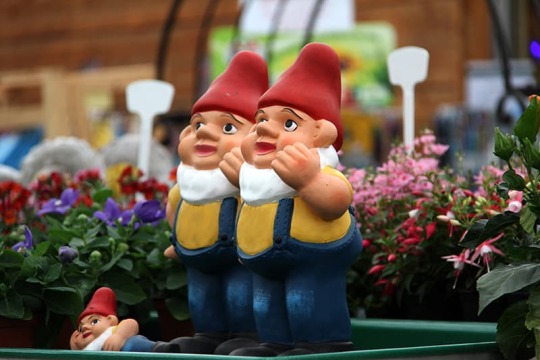
The Garden Gnome trademark has always been the so-called Phrygain Cap
The garden gnome trademark has always been the so-called Phrygian cap. It’s a soft, conical hat, usually painted bright red. It originates from the Hellenistic period, as it is preserved in depictions in Greek vase-painting and sculpture.
Nowadays, the hat is known as a Gnome and has got a brand new meaning. In revolutionary France, the Phrygian-style cap became a symbol of revolt against the establishment, called "Bonnet rouge." It was first documented in 1870.
This is why the national symbol of France, Marianne, is always depicted wearing a red Phrygian cap. Since Marianne is a personification of liberty and equality, it is easy to bring together such tradition with the aforementioned Traveling Gnome prank, whose aim was to free gnomes from their garden prisons. No wonder this joke has bloomed in France, the very cradle of the modern concept of liberty.
Making of Garden Gnomes
Garden gnomes are typically shaped in the human form as small statues. Through centuries, they have been traditionally handmade from terracotta clay, using a mold. Once its shape got firm, the gnome could be removed from the mold.
The next step was drying and heating in a kiln, a special type of oven used for firing pottery until it got hard. The final step included painting and brushing the gnome in bright colors.
With the development of technology, the manufacturers started to use some other materials, such as resins and, more lately plastic.
Today, there are many tutorials on how to make a garden gnome at home available online.
Types of Garden Gnomes
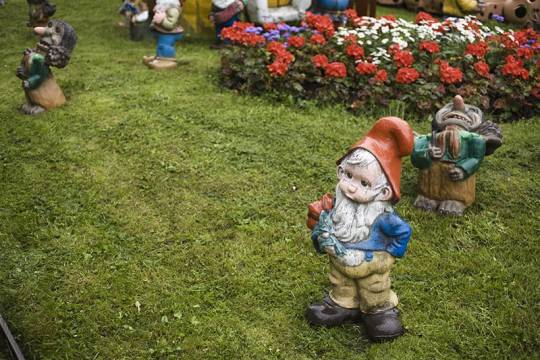
The details of the appearance of garden gnomes have gone through many changes over the centuries.
The majority of them are shaped as males with long, white beards and pipes. Female gnomes were rather rare and usually without the beard, but having a simple dress, and the same pointed hat as the male ones. It is why they can look somewhat like witches. They can also be displayed as a gnome family, consisted of a mother, father, and children.
Since they were supposed to help with sweeping and planting, according to the legend, traditional garden gnomes were usually depicted holding garden tools such as shovels or wheelbarrows. More modern gnomes are rather represented during their spare time – reading, fishing or napping.
Uses of Gnomes In The Garden
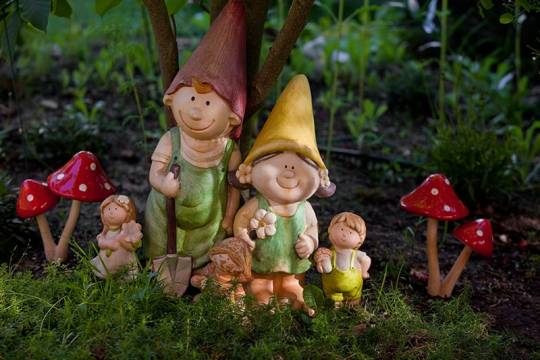
There are various uses of gnomes in gardening. They can be put on different places around the garden or around the house: hidden in your backyard, in the flower beds or bushes.
Gnomes will also do well as decoration near a water feature - a pond or a fountain; they can reflect in the water. They can also be incorporated in solar lighting installations.
Also, a garden gnome can be placed somewhere around the front yard, for example at the front steps, where he can serve as a centerpiece. In the context of front yards, gnomes can make dull lawn patches more fun and interesting.
Gnomes, from Gardening to Popular Culture
As I mentioned before, garden gnomes became a significant part of popular culture nowadays, having appeared in many movies, commercials, and video games. After gaining popularity in Disney’s "Snow White and Seven Dwarfs," gnomes played roles in several more movies and books.
From a popular open-source desktop environment for Unix-like operating systems named GNOME to the marketing use of gnomes by the Social Democratic Party of Austria, gnome-like creatures remained the popular determinant of western culture. Not to mention famous novels written by J.R.R. Tolkien, C.S. Lewis, J.K. Rowling, and Terry Pratchett.
Travelocity, an American online travel agency launched a series of viral marketing advertisements called "Where is my Gnome?" Its mascot, a very well-known garden gnome with black boots and red hat, became known as "the Roaming Gnome." Travelocity also created an official profile for the Roaming Gnome on Instagram and Twitter. Fans can follow his international escapades regularly, watching photographs of a cute gnome eating pizza in Italy, traveling on a plane or striking a pose in front of the Golden Gate Bridge in San Francisco.
The cover of the famous George Harrison’s solo album "All Things Must Pass" contains gnomes that belonged to Sir Frank Crisp at Friar Park in Oxfordshire, another British gnome collector from the late 19th century.
Onto the big screen, "Gnomeo and Juliet" and its sequel "Sherlock Gnomes," are British-American production animated movies. The original was inspired by Shakespeare’s tragedy "Romeo and Juliet," using its plot to tell a story in which gnomes are the main characters, reuniting two families, that used to be enemies. Art can use different traditions very well, and this movie is a good case in point.
One of the contemporary marks of garden gnomes is the process of their personification. Sometimes, they are given a specific voice and personality, to serve some artistic or comical purpose. One of the more famous examples is the Gnome Chomsky, made after Noam Chomsky, an American philosopher, linguist, and political activist, and he could be ordered online in several sizes.
There are also several gnome festivals around the world, conducted in many countries from the United States to Australia, celebrating those mythical creatures.
Garden Gnome Aesthetical Debate

The garden gnomes we banned in the Chelsea Flower show until 2013
The fame always comes with a flipside. It is certain that garden gnomes have a love-hate relationship with the public. A notorious example of that is the Chelsea Flower Show.
After years of appeals and protests, in 2013 the Royal Horticultural Society of Britain lifted a ban on using garden gnomes at the Chelsea Flower Show, to the joy of gnome lovers and to the horror of those who see the garden gnomes as the ultimate kitsch. The latter group has often been labeled "garden snobs" and "gnomophobes."
Since the Chelsea Flower Show is the most influential garden-related event in a country with a long gardening tradition, such a debate was expected.
Conclusion
From the very beginning of Western civilization, gardening was an important element of everyday life and relaxation. Garden gnomes have been given a big role in it. Related specifically to the gardening tradition, they remained the most common stereotype of home gardens across the world. Garden gnomes are a sweet cliché.
On the other hand, seen as kindred spirits and human little helpers, deeply rooted in our tradition and mythology, they became an inevitable part of every childhood. The stories they portray maintain the continuity of the culture, even beyond gardening.
Do you have garden gnomes in your garden? Do you think they are beautiful artistry or the expression of bad taste? And lastly - aren’t gnomes just cute? What do you think? Let us know in the comments.
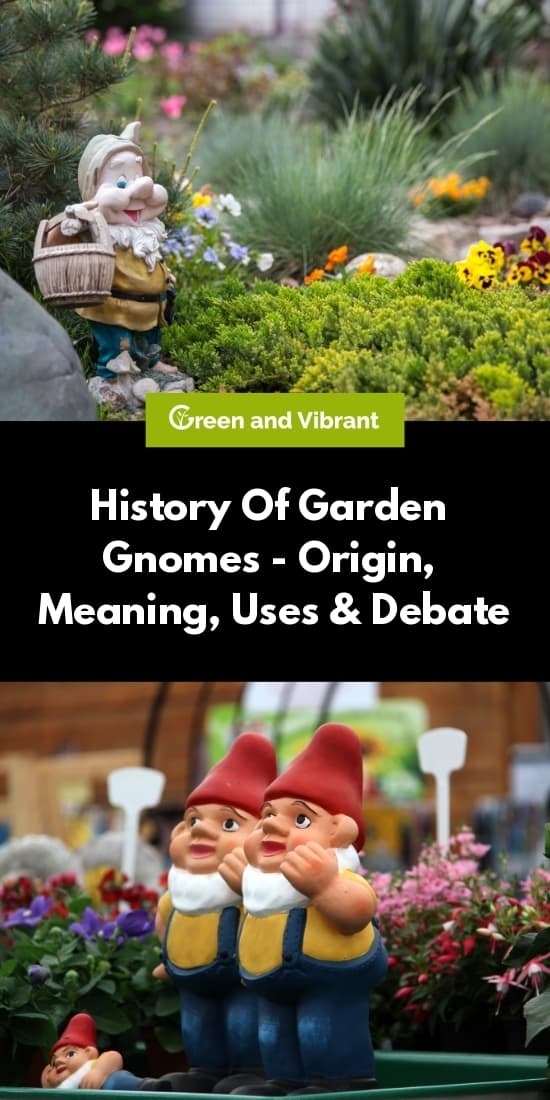
Thank you for your article! It was much appreciated my thoughts on it are coming! Some of these things really made me think 😳
https://www.greenandvibrant.com/history-of-garden-gnomes
#gnomelove#gnomegirlgabby#gnomes#gardengnomes#gnomesgnomesgnomes#gnomewant#neededgnomes#GnomeArticle#GreenAndVibrantGnomes#MaxGnomes#GnomeFacts
0 notes